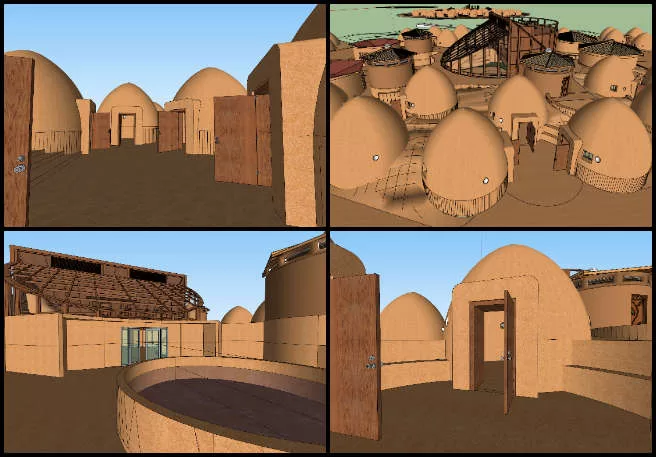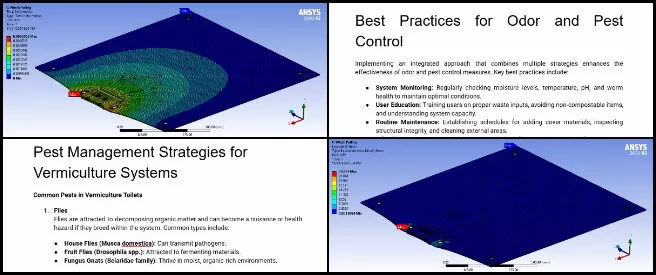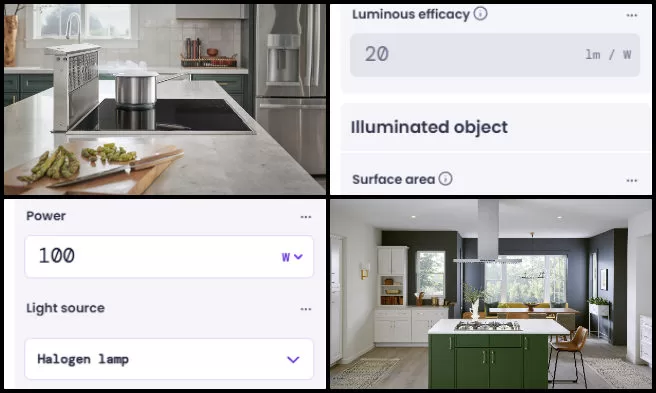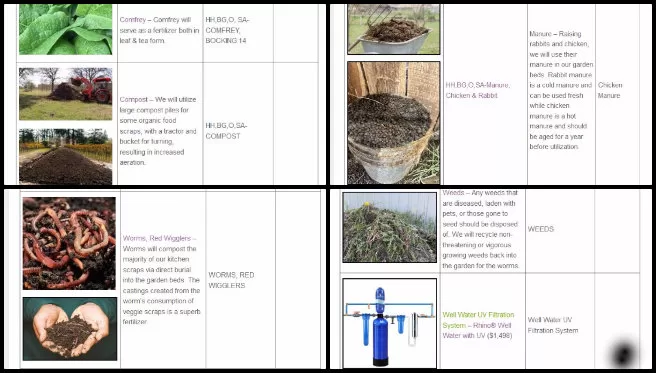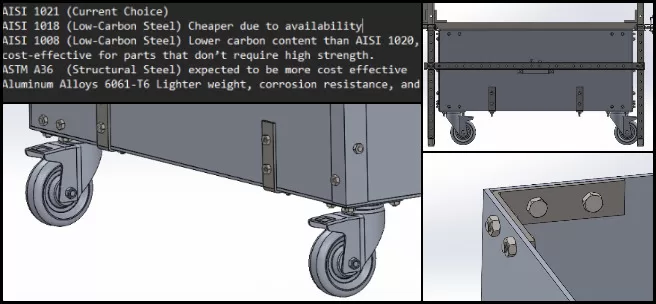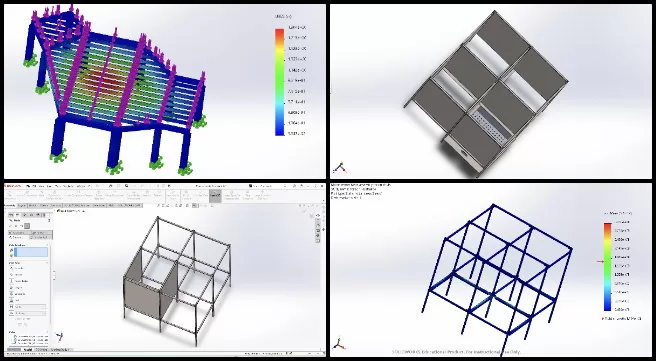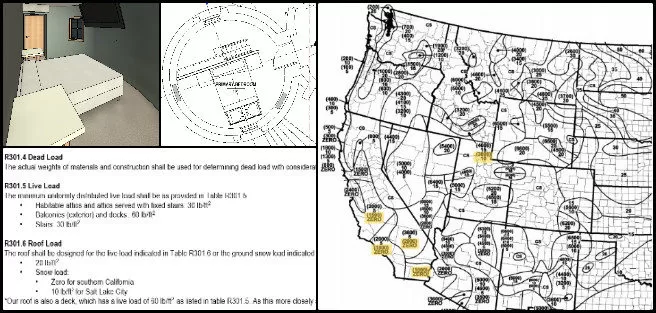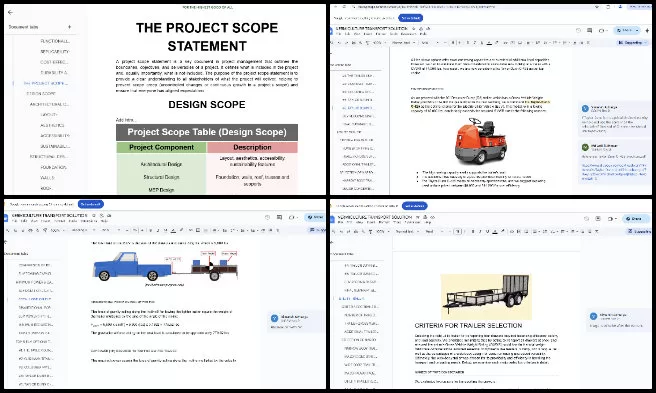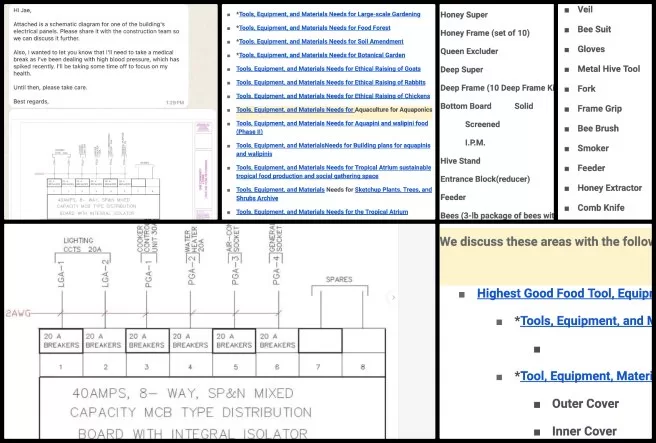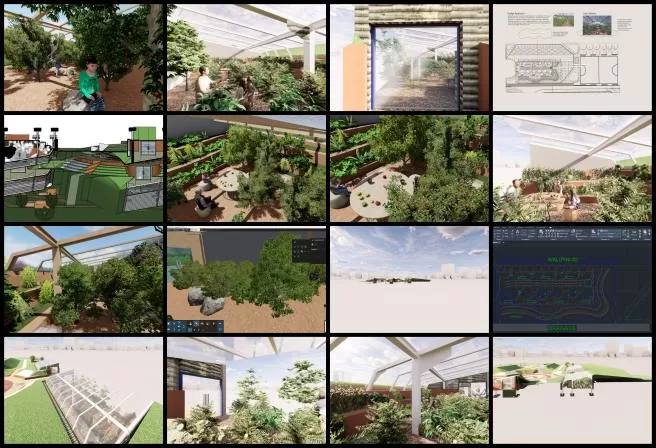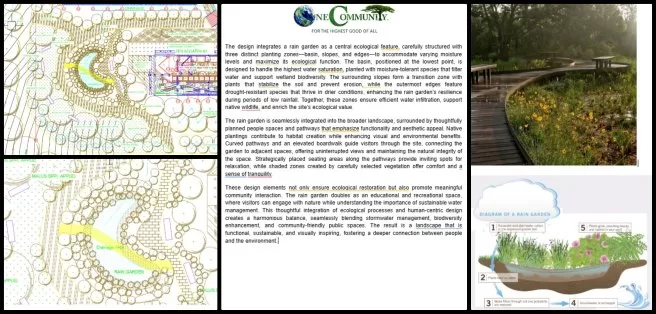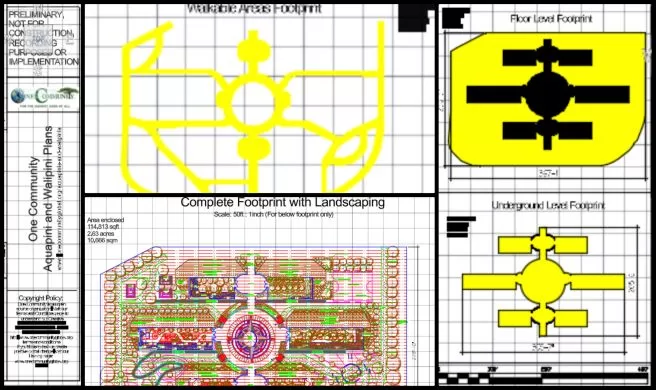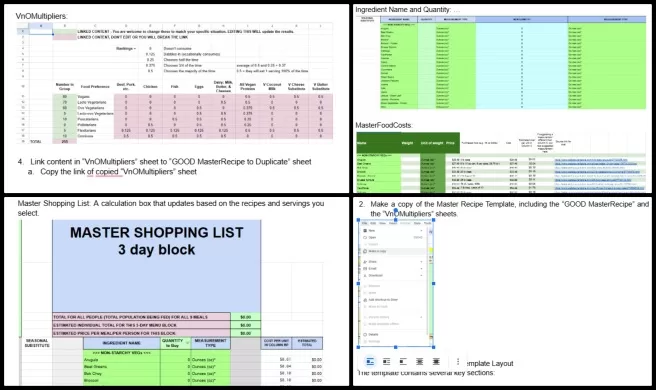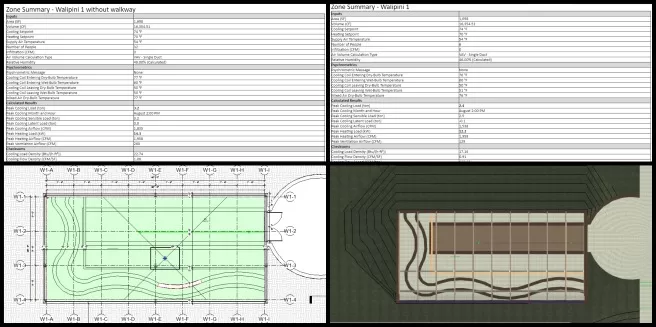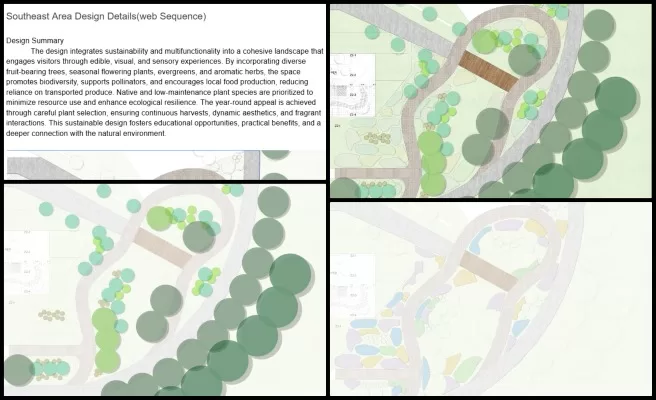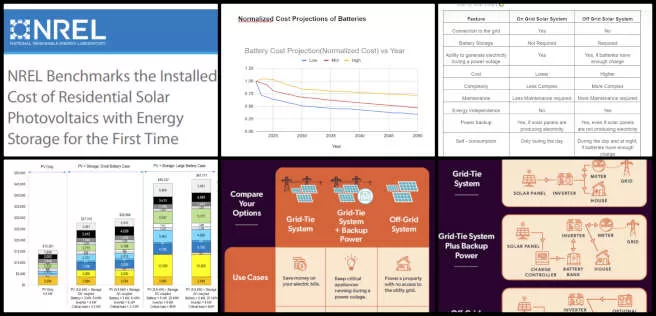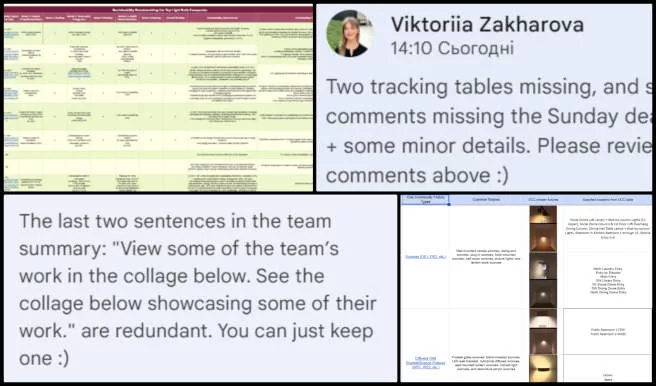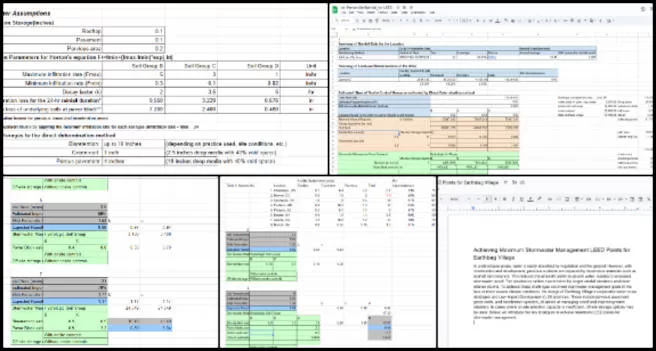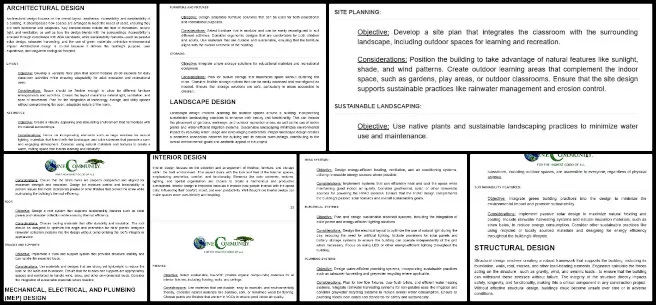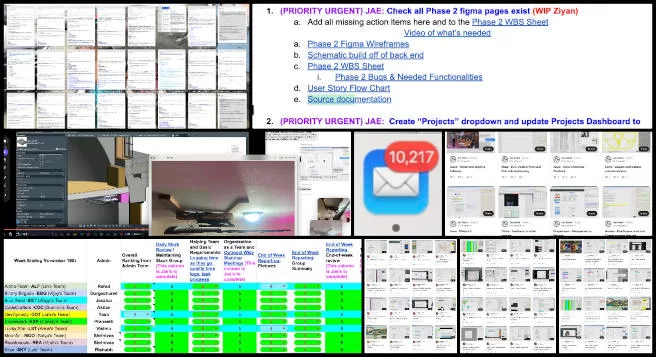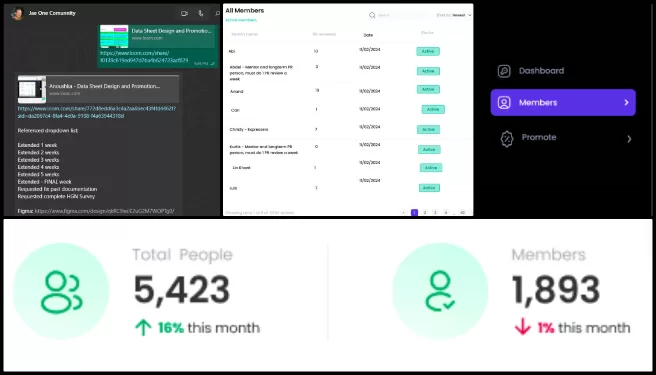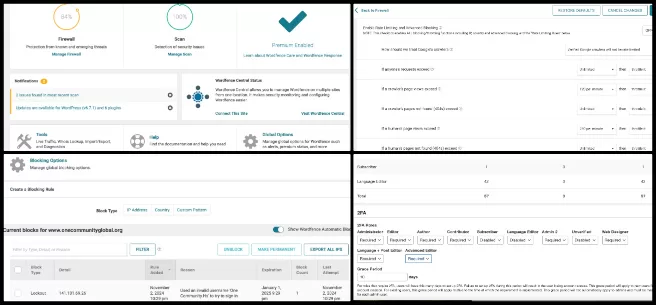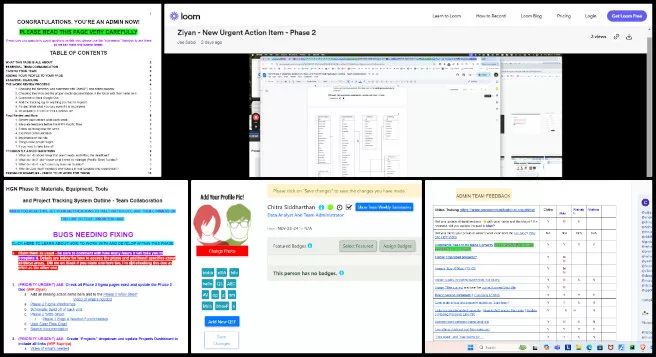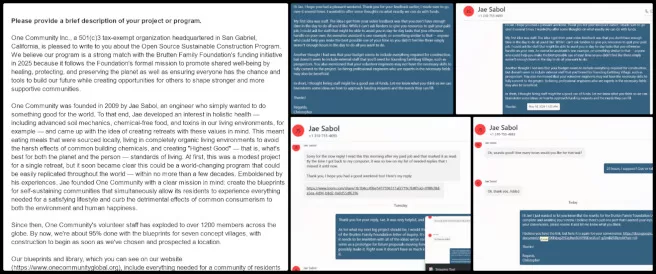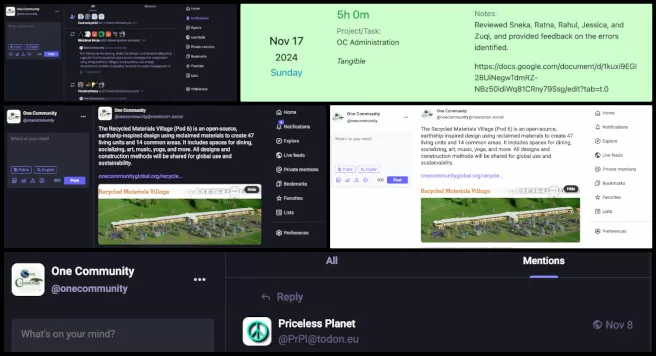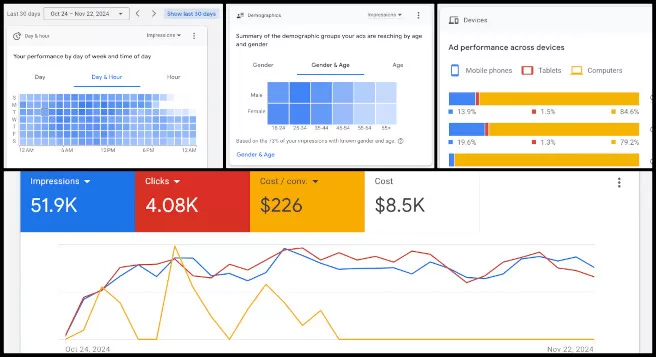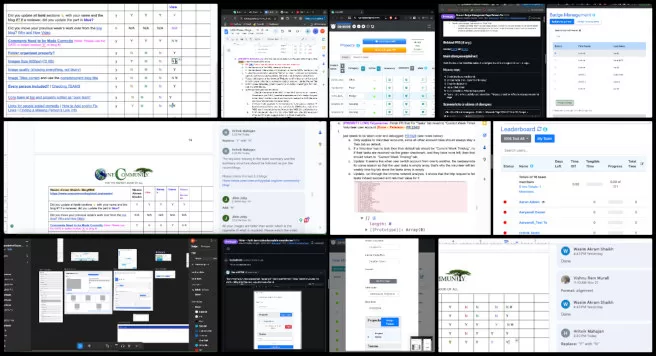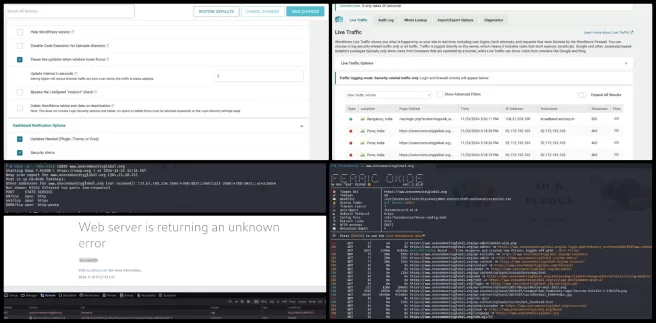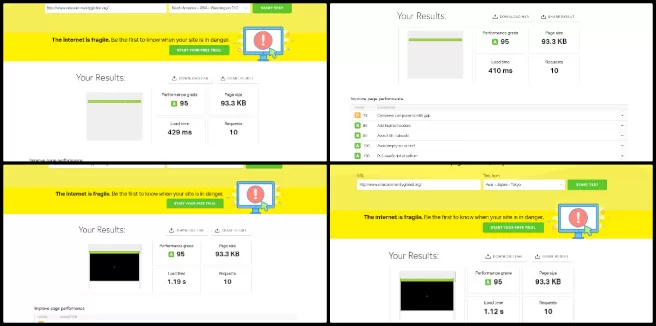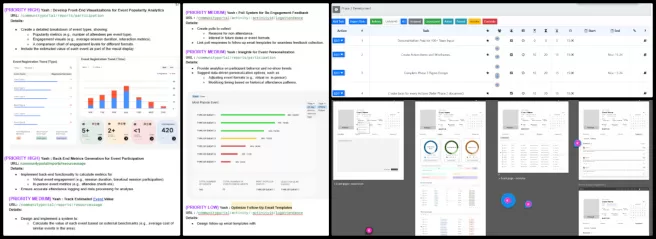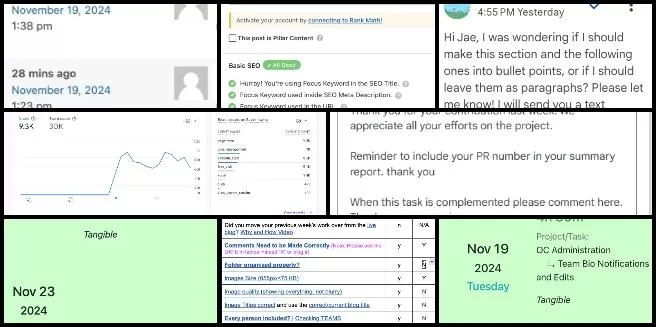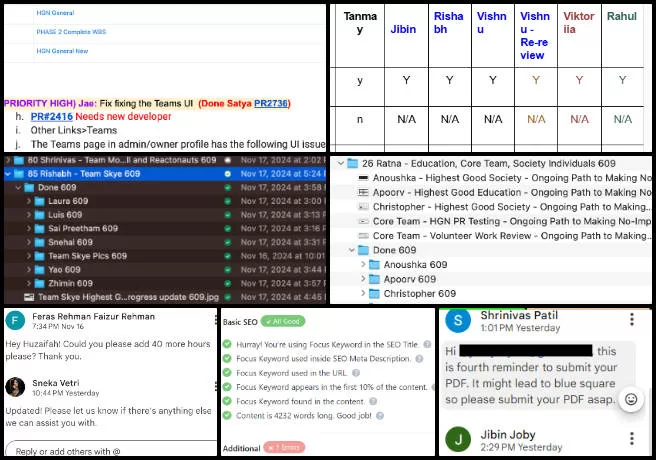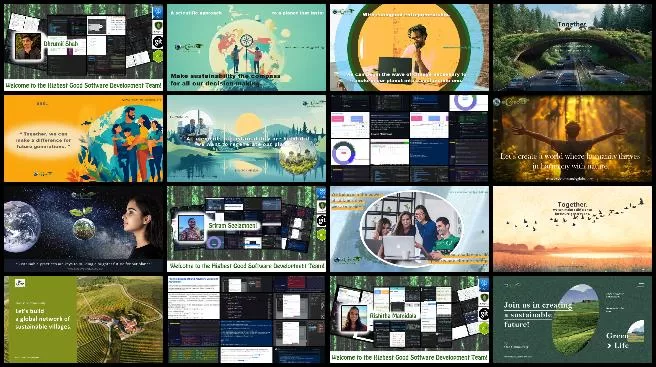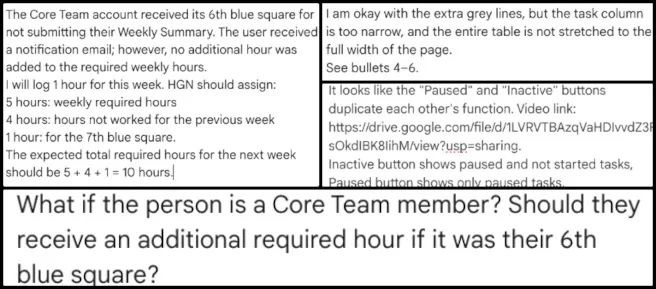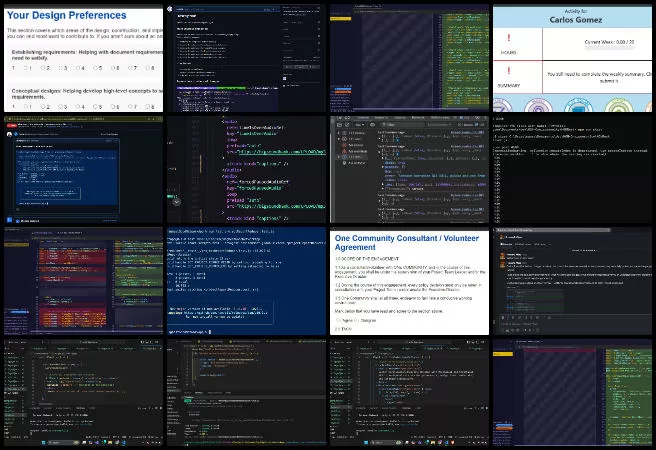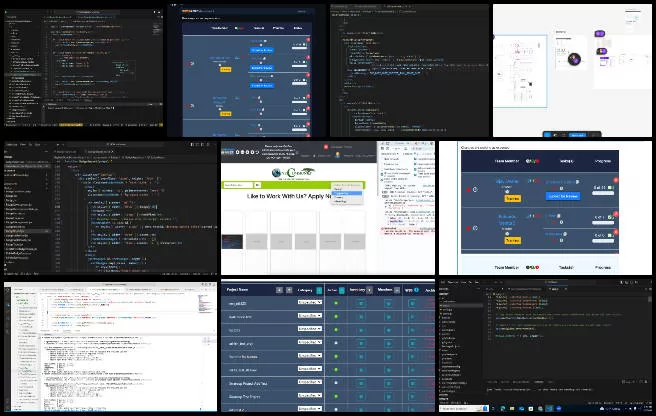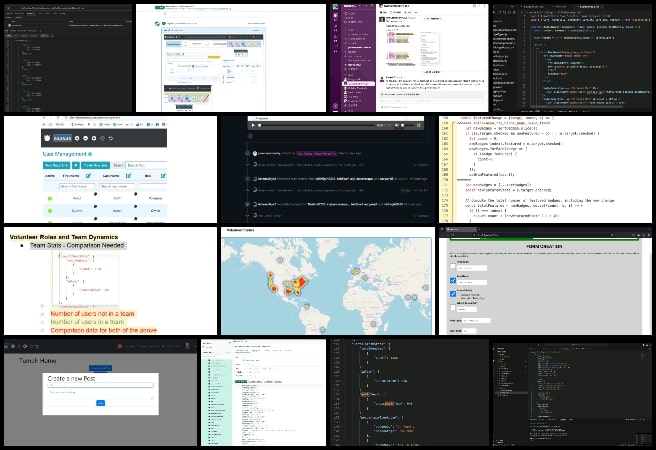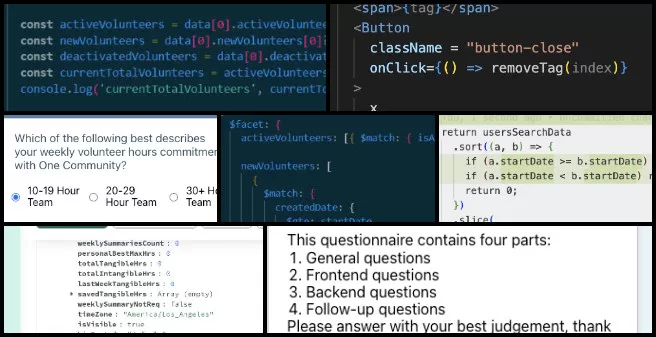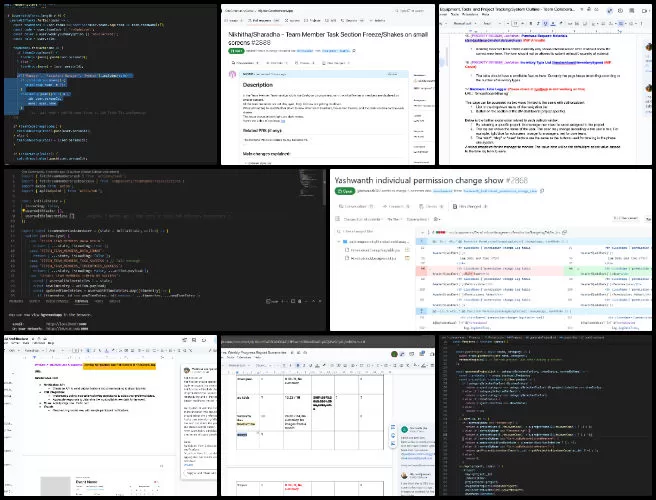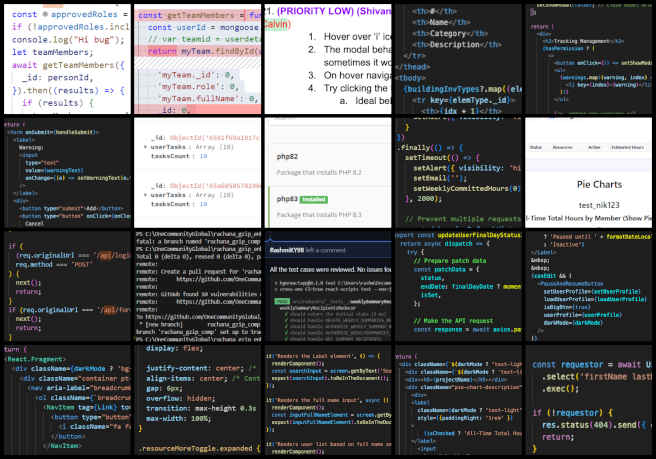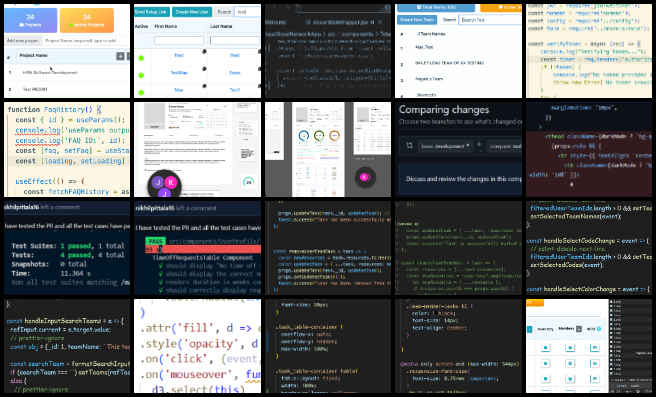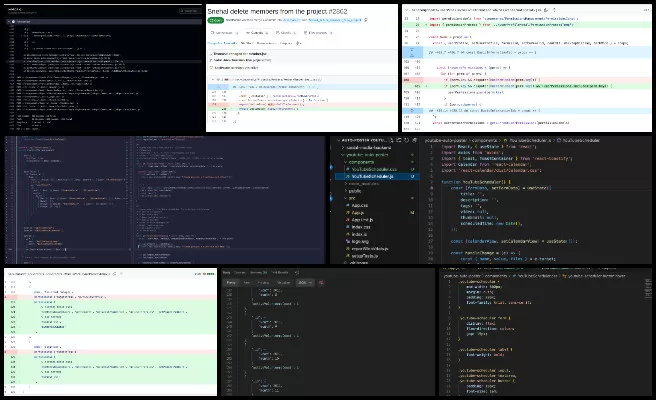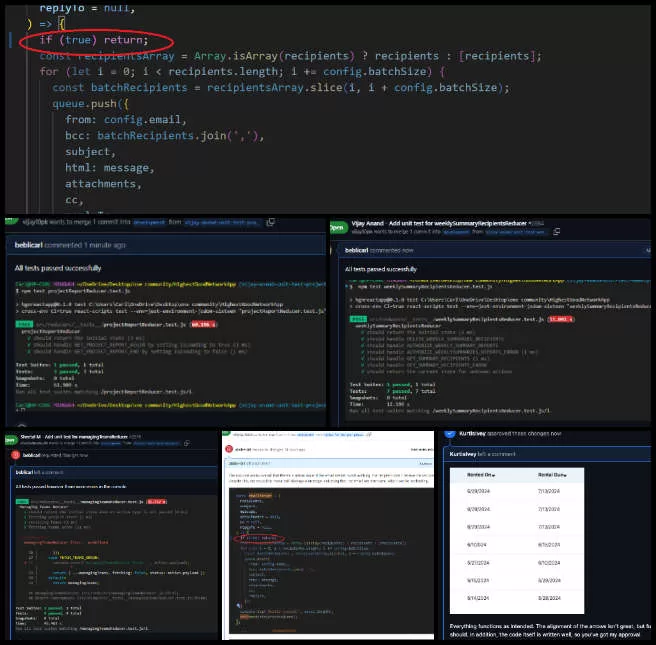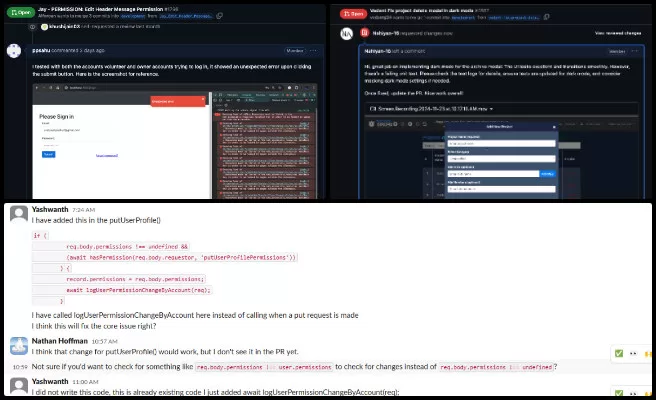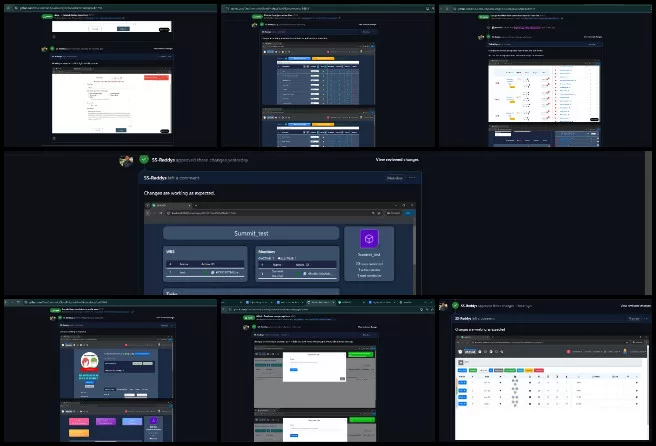Cooperatively Building a World that Works for Everyone – One Community Weekly Progress Update #610
At One Community, we are cooperatively building a world that works for everyone to regenerate our planet and create positive change. Our all-volunteer team is focused on sustainable approaches to food, energy, housing, education, economics, and social architecture. By open sourcing and freely sharing sharing the complete process, we aim to build a self-replicating model that inspires a global collaboration of teacher/demonstration hubs, all for “The Highest Good of All.” Together, we are evolving sustainability and fostering global stewardship practices that promote fulfilled living and lasting impact.
- Here’s our project overview on cooperatively building a world that works for everyone
- Here’s our world-change methodology
- Here’s how this becomes self-replicating
- Here’s how we are open source and free-sharing all the do-it-yourself designs
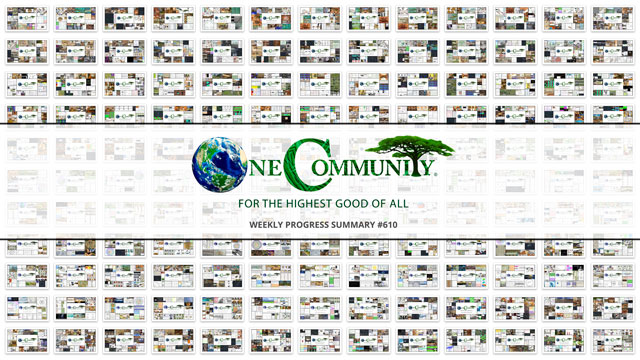
OUR MAIN OPEN SOURCE HUBS
Click on each icon to be taken to the corresponding Highest Good hub page.
One Community’s physical location will forward this movement as the first of many self-replicating teacher/demonstration communities, villages, and cities to be built worldwide essentially for cooperatively building a world that works for everyone. This is the November 25th, 2024 edition (#610) of our weekly progress update detailing our team’s development and accomplishments:
Cooperatively Building a
World that Works for Everyone
One Community Progress Update #610
DONATE | COLLABORATE | HELP WITH LARGE-SCALE FUNDING
CLICK HERE IF YOU’D LIKE TO RECEIVE AN EMAIL EACH WEEK WHEN WE RELEASE A NEW UPDATE
YOU CAN ALSO JOIN US THROUGH SOCIAL MEDIA
ONE COMMUNITY WEEKLY UPDATE DETAILS
HIGHEST GOOD HOUSING PROGRESS
 One Community is cooperatively building a world that works for everyone through Highest Good housing that is artistic and beautiful, more affordable, more space efficient, lasts longer, DIY buildable, and constructed with healthy and sustainable materials:
One Community is cooperatively building a world that works for everyone through Highest Good housing that is artistic and beautiful, more affordable, more space efficient, lasts longer, DIY buildable, and constructed with healthy and sustainable materials:
- Learn about cooperatively building a world that works for everyone: Our Upcoming Crowdfunding Campaign
- Learn about the different village models: 7 Sustainable Village Models
- Visit the open-source portals for the first two: Earthbag Village OS Hub | Straw Bale Village OS Hub
This week, Adil Zulfiquar (Engineer) continued working on the Vermiculture Toilet engineering and designing an ongoing path to making mainstream no-impact living; which is part of cooperatively building a world that works for everyone. His work centered on refining the vermiculture transportation report by incorporating changes suggested during multiple reviews. Backups were created for all referenced videos and PDF articles used in the report. Updates were made to the Excel lists that generate images for the report, and a backup was created for the website. A new safety section was added for operating the utility trailer, including pictorial illustrations. The report was further revised to enhance readability and presentation. The Earthbag Village is the first of 7 to be built as the housing component of One Community’s open source model for cooperatively building a world that works for everyone. See below for some of the pictures related to work.
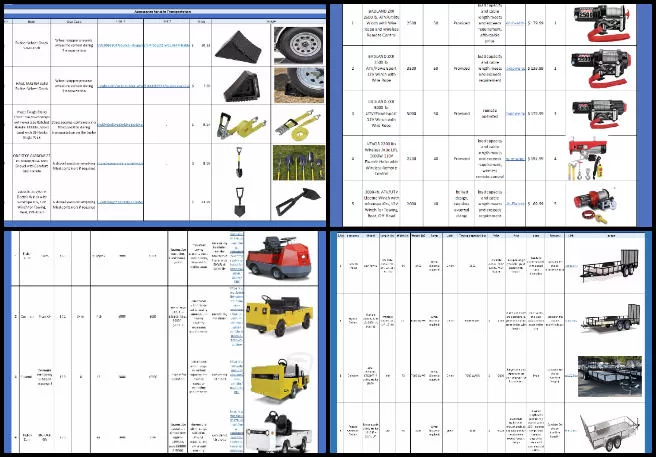
Akshit Sethi (Architectural Designer) continued working on updating the Earthbag Village SketchUp and AutoCAD layouts. Akshit worked on completing the base file for the SketchUp model of the EarthBag Village. His tasks included incorporating the atrium space, adjusting the ramp and door design to allow service vehicle entry, and integrating internal and external clusters. These updates established the foundational elements of the EarthBag Village model for further development. The Earthbag village is the first of 7 villages to be built as part of One Community’s open source model for cooperatively building a world that works for everyone. See his work in the collage below.
Anil Karathra (Mechanical Engineer) continued helping complete the Vermiculture Toilet engineering and designs. He focused on team activities, including managing weekly summaries and reviewing past work to ensure alignment with project goals; towards cooperatively building a world that works for everyone. Updates were made to the table of contents, bookmarks, and links, with formatting adjustments applied to the pest management section. The winch pull-out calculations document was revised with updated images and formatting, with a final review and touch-ups pending. Modifications were made to the hammer impact documentation based on recent feedback, and a new finite element analysis was conducted for the winch pull-out using a redesigned slider. The approach for cooperatively building a world that works for everyone enables the development of innovative solutions that are both environmentally friendly and effective. See below for some of the pictures related to the work.
Avery Hamilton (Mechanical Designer) continued working on finalizing the interior of the Earthbag Village 4-dome home design as a strategy for cooperatively building a world that works for everyone. Avery refined Revit schedules, finalized equipment layouts to align with project requirements, verified MEP system coordination with architectural plans, adjusted piping layouts for efficiency, and updated the Revit model with revised equipment specifications. He also created draft details for venting systems and prepared a mechanical and electrical coordination PDF to support interdisciplinary collaboration. The Earthbag village is the first of 7 villages to be built as part of One Community’s open source model for cooperatively building a world that works for everyone. See the work in the collage below.
Charles Gooley (Web Designer) continued working on the Aircrete Engineering and Research: Compression Testing, Mix Ratios, R-value, and More page. Charles updated the Aircrete Engineering and Research: Compression Testing, Mix Ratios, and R-value page, detailing the engineering steps, research, resources, and tools used to assess the safety of aircrete designs and structures. He identified sections in the related design document that need further clarification and expanded the content on the Tools and Equipment for Open Source Construction master page. Aircrete is an alternative we’re exploring for the Earthbag Village, a foundational part of One Community’s open-source model for cooperatively building a world that works for everyone. Take a look at some of the work in the images below.
Joseph Osayande (Mechanical Engineer) continued helping finish the Vermiculture Toilet engineering and design details. Joseph focused his efforts on cooperatively building a world that works for everyone; the drawer design was revised by adjusting its dimensions and fittings to align with the updated wall structure for improved compatibility within the chamber. Modifications to the Waste Removal System (WRS) included aligning the U-brackets with the updated drawer positioning. Finite Element Analysis (FEA) tests were planned to evaluate alternative unistrut materials for cost and performance. Research was also initiated to identify the most suitable material for the WRS, considering both performance and cost factors. The Earthbag Village is the first of 7 to be built as the housing component of One Community’s open source model for cooperatively building a world that works for everyone. See some of his work in the collage below.
Karthik Pillai (Mechanical Engineer) continued helping finish the Vermiculture Toilet engineering and helping with the Earthbag Village 4-dome home roof plan. For the vermiculture toilet will essentially promote cooperatively building a world that works for everyone Karthik worked on refining the roof joist design by testing various dimension combinations to reduce deflection to less than one inch. Simulation results showed a maximum deflection of 1.9 inches, leading to the identification of potential structural adjustments for optimization. Progress was also made on the vermiculture toilet design, with an assembly model developed to address coverage issues by minimizing structural gaps. Finite element analysis (FEA) is in progress to evaluate the assembly’s structural performance, focusing on ensuring functionality and reliability under operational conditions. The Earthbag Village is the first of 7 to be built as the housing component of One Community’s open source model for cooperatively building a world that works for everyone. See the work in the collage below.
Michaela Silva (Architect) continued working on finalizing the interior details for the Earthbag Village 4-dome home design. Michaela conducted structural research for the design of the 4-dome roof structure, reviewing live and dead load requirements from the California Residential Code and updating the building code sheet in Revit with the relevant sections. She also resolved a coordination issue between the mini-split and TV placement in the primary bedroom. The Earthbag Village is the first of 7 villages to be built as part of One Community’s open source model for cooperatively building a world that works for everyone. See her work in the collage below.
Vimarsh Acharya (Engineering Manager and Technical Reviewer) continued working on identifying sustainability-related arguments covering the Highest Good Lifestyle Considerations and sourcing quality research to support each one. The research support will definitely enhance cooperatively building a world that works for everyone. His work on reviewing the “Vermiculture Container Transport Solution” document involved implementing changes and addressing questions. The “Ultimate Classroom Structural Design” document is now in the final review stage. Earlier revisions, suggested by Jae and the user, were completed by Apoorv, and the current effort is directed toward rechecking and verifying the document for any remaining issues or uncertainties. The One Community model of combining forward-thinking education with sustainably built classrooms like this is an excellent example of cooperatively building a world that works for everyone. See the collage below for his work.
DUPLICABLE CITY CENTER PROGRESS
 One Community is cooperatively building a world that works for everyone through a Duplicable and Sustainable City Center that is LEED Platinum certified/Sustainable, can feed 200 people at a time, provides laundry for over 300 people, is beautiful, spacious, and saves resources, money, and space:
One Community is cooperatively building a world that works for everyone through a Duplicable and Sustainable City Center that is LEED Platinum certified/Sustainable, can feed 200 people at a time, provides laundry for over 300 people, is beautiful, spacious, and saves resources, money, and space:
- Learn about this building and its function: Duplicable City Center Open Source Hub
This week, Adithya Bhalaji (Mechanical Engineer) continued exploring various types of dormer designs available in the market and studied commonly used materials for windows and dormer construction, focusing on their insulation properties for the dormer interior. He focused on creating part drawings for individual components of the second-floor dormer design. The designs will cooperatively building a world that works for everyone. This involved referencing stackups and dimensions from the first-floor dormer design and making design assumptions to accommodate the incline caused by the steep angle changes in the dome structure and stacked diamond assembly. Additionally, considerations were made for the attachment methods of these parts. As previous concept explorations required a fresh approach, the design process started with initial concept sketching and development before progressing to assembly creation. The current scope of work includes the overall dormer structure, with remaining tasks involving the addition of insulation, an already-designed window frame, and the outer enclosure, which are planned to be addressed in the near term. The Duplicable City Center represents a fundamental element of One Community’s open-source approach, dedicated to cooperatively building a world that works for everyone. View examples of this work in the pictures provided below.![]()
Arnob Mutsuddi (Mechanical Engineer) continued working on the Duplicable City Center’s structural engineering model and details. He worked on the Row 6 hub connector design, which progressed with continued efforts on angle alignment and middle ring integration. The design process included aligning four side struts with the middle ring and addressing the angle alignment between the side struts and the middle ring. Three side struts were fully aligned, and adjustments to the remaining alignments are still in progress. The Duplicable City Center is a foundational part of One Community’s open-source model, which excels in cooperatively building a world that works for everyone. This approach is integral to their mission of cooperatively building a world that works for everyone through innovative and scalable solutions. See some of this work in the pictures below.
Chris Blair (GIS Technician/Horticulturist) continued working with GIS data as part of One Community’s Permaculture Design that includes the location of the Duplicable City Center. He worked with GIS data as part of One Community’s Permaculture Design. Using accurately scaled footprints of the villages and city center, he analyzed and placed them in optimal locations on the property, taking into account level ground and solar aspect. He also created maps displaying the original village locations alongside proposed relocation suggestions. Within One Community’s open-source framework, the Duplicable City Center plays a central role in cooperatively building a world that works for everyone. The images below showcase some of this work.
Faeq Abu Alia (Architectural Engineer) continued his work on the Duplicable City Center kitchen. He worked on refining the Duplicable City Center kitchen model in SketchUp, addressing design issues and incorporating feedback to improve its overall quality. He enhanced the model by adding human figures to provide a realistic perspective. In Lumion, he adjusted materials, included additional human figures, and developed three walkthrough paths for the kitchen. Key shots were rendered to improve the visual presentation and ensure alignment with project requirements. The Duplicable City Center represents a fundamental element of One Community’s open-source approach, dedicated to cooperatively building a world that works for everyone. View examples of this work in the pictures provided below.
Jason Bao (Architectural Designer) continued working on producing renders for the Duplicable City Center library. He made adjustments and updates to previous renders based on feedback from the weekly report. New ceiling lights were added to both the SketchUp and Lumion models to enhance interior lighting, aligning with a referenced lighting case study. Disposable containers were removed from all scenes, and the sport night scene was re-rendered with updated lighting. Books on the library’s shelves were re-textured to increase visual diversity, and minor clipping issues were resolved before re-rendering parts of the reading scene. The library layout for the education scene was revised, repositioning the tutor to the inner side of the group and surrounding them with students. Additional adjustments included rearranging furniture, textures, and items to achieve a corrected look, followed by rendering for economic and permaculture design education scenes. Work also began on constructing the game night scene, which involved rearranging furniture, adding game-related assets, and making lighting adjustments. The Duplicable City Center is a foundational part of One Community’s open-source model, which excels in cooperatively building a world that works for everyone. This approach is integral to their mission of cooperatively building a world that works for everyone through innovative and scalable solutions. See some of this work in the pictures below.
Nika Gavran (Industrial Designer) continued her work on the Duplicable City Center dormer window installation plans. She focused on expanding the final document for the dormer window instructions, incorporating feedback received on the design and renders. She began implementing changes, including adjusting the roof of the dormer to have a greater slope. This involved researching the appropriate slope for the specific structure size and updating the CAD model accordingly. Additionally, Nika researched waterproof roofing solutions and started a new page with detailed descriptions for cutting the rock wool insulation. As a foundational component of One Community’s open-source strategy, the Duplicable City Center is designed for cooperatively building a world that works for everyone. The images below showcase some of this work.
Rudrani Sravya Mukkamala (Mechanical Engineer) focused on researching the structural components of a hydraulic elevator, covering aspects such as the framework, guide rails, and load-bearing elements. Simultaneously, she worked on developing a design plan, integrating insights from the research into preliminary sketches and diagrams. Cooperatively building a world that works for everyone is truly attainable through well-designed strategic planning. The type of hydraulic elevator was determined based on its intended usage and an evaluation of each system’s merits and demerits. This effort aimed to align the structural design with functional requirements. Within One Community’s open-source framework, the Duplicable City Center plays a central role in cooperatively building a world that works for everyone. The images below showcase some of this work.
Sanket Basannavar (Mechanical Engineer) continued working on the Duplicable City Center spa cover as part of the City Center Natural Pool and Eco-spa Designs. He identified a design defect in the spa cover, specifically a gap between the panels. The design was updated by incorporating rubber insulation material to eliminate the gap, and the thermal analysis was rerun, showing improved efficiency. Additionally, a report detailing the updated spa cover design was completed. Within One Community’s open-source framework, the Duplicable City Center plays a central role in cooperatively building a world that works for everyone. The images below showcase some of this work.
Tasmia Hasan (Design Engineer) continued her work on the structural engineering of the Duplicable City Center. She worked on adjusting the row one angle of the frame to achieve proper alignment. She calculated and applied 66.18 degrees for the intermediate angles and 56.99 degrees for the angles on the two sides. To simplify the process, she removed the screws and inner ring, enabling easier adjustments using the Direct function for precise modifications. As a foundational component of One Community’s open-source strategy, the Duplicable City Center is designed for cooperatively building a world that works for everyone. You can see examples of this work in the following images.
Umema Ali (Mechanical Design Engineer) continued working on the Duplicable City Center Engineering. She worked on the static structural analysis of a new dome structure, focusing on evaluating its performance under snow loads of 10 and 20 lbs. Using Inventor, she analyzed the displacement and stress values resulting from the application of a uniformly distributed load. The analysis aimed to assess the structural integrity of the dome under varying conditions, providing data on how the structure responds to these specific load scenarios. Within One Community’s open-source framework, the Duplicable City Center plays a central role in cooperatively building a world that works for everyone. The images below showcase some of this work.
Yancong E (Architectural Designer) continued working on the Duplicable City Center project. He updated the Outdoor View Floor Plan to align with the latest revisions, adjusting dead areas and recalculating viewable area percentages for each room. He revised the overall analysis description to ensure alignment with the website and conducted individual floor analyses to identify specific details and determine which rooms qualify for points. The Duplicable City Center represents a fundamental element of One Community’s open-source approach, dedicated to the ongoing path to making no-impact living mainstream. This innovative initiative aims to showcase how an ongoing path to making no-impact living mainstream can transform urban spaces into more sustainable and community-oriented environments. You can see examples of this work in the following images.
HIGHEST GOOD FOOD PROGRESS
 One Community is cooperatively building a world that works for everyone through Highest Good food that is more diverse, more nutritious, locally grown, and sustainable, and part of our open source botanical garden model to support and share biodiversity:
One Community is cooperatively building a world that works for everyone through Highest Good food that is more diverse, more nutritious, locally grown, and sustainable, and part of our open source botanical garden model to support and share biodiversity:
- Learn about the structures: Hoop House Hub | Aquapini & Walipini Open Source Hub
- See what we’ll be growing: Gardens & Hoop Houses | Large-scale Structures | Food Forest | TA
This week, the core team completed the review of the Apiary and portions of the Earthbag Tools, Equipment, and Material/Supplies lists. They also reviewed the electrical plan for the Earthbag Village, examining individual circuits and suggesting uniform wire gauges and appropriate breaker amperes. An electrical reassessment will be conducted for the 4-dome cluster. The Earthbag Village is the first of 7 to be built as the housing component of One Community’s open source model for cooperatively building a world that works for everyone. See below for some of the pictures related to this work.
Jay Nair (BIM Designer) continued working on Aquapini and Walipini Planting and Harvesting lighting and HVAC design. He focused on advancing the greenhouse design by resolving challenges encountered during the heat load analysis in Revit addressing software limitations and errors. Addressing the challenges is important in cooperatively building a world that works for everyone. Research into alternative methods for performing the analysis was undertaken to achieve accurate results aligned with the greenhouse’s requirements. A work breakdown structure (WBS) was developed for HVAC and plumbing designs to facilitate task assignments and project planning. Additionally, Jay reviewed resumes to evaluate candidates for mechanical engineering roles, prioritizing the selection of individuals with relevant expertise to support the design and analysis phases of the project. The Highest Good Food initiative is a key component of One Community’s open source plans, dedicated to cooperatively building a world that works for everyone and exemplifies the organization’s commitment through innovative design and implementation. Below are some of the images showcasing this work.
Junyi Shi (Landscape Architect) started working on developing a design for Walipini #2 as a part of Aquapini and Walipini Planting and Harvesting project. A project that can lead to cooperatively building a world that works for everyone Her work on the CAD design concentrated on integrating a people space function into the Walipini 2 fruit greenhouse. After analyzing and researching potential options, a design plan for the people space was selected. The CAD design was synchronized with the SketchUp model, beginning with sectional views and utilizing SketchUp and Enscape to create 3D representations for improved spatial visualization. Corrections were also made to errors in the original Lumion model, which included replacing incorrect tree species and fixtures with accurate ones, followed by rendering perspective images to showcase the updated design. The Highest Good Food initiative is essential to One Community’s open source plans, focused on promoting a sustainable approach to cooperatively building a world that works for everyone. Her contributions are highlighted in the collage below.
Purva Borkar (Landscape Architect) continued with her work on creating an outdoor merge of a food-producing ecosystem and people spaces for the Aquapini and Walipini Planting and Harvesting structures. She focused on refining the CAD design to enhance accuracy and detail in the project layout. She also conducted research to identify and integrate relevant design features, improving both functionality and aesthetics which is a special feature for cooperatively building a world that works for everyone. Additionally, Purva worked on drafting a report that provides a thorough explanation of the overall design, highlighting its key components and objectives. As part of One Community’s open source efforts, the Highest Good Food initiative embodies a commitment to cooperatively building a world that works for everyone. The images below offer a glimpse into these ongoing efforts.
Surya Teja Anumolu (Volunteer Mechanical Engineer) continued his work on the Highest Good Food most sustainable construction and agricultural equipment. He focused on refining Aquapini and Walipini Planting and Harvesting footprint drawings to include scale bars and legends at each level for the different types of footprints created last week. Using the master AutoCAD file from the One Community Dropbox folder, he combined five distinct drawings to create the final file for the Aquapini and Walipni databases. The Highest Good Food initiative is a key component of One Community’s open-source plans, dedicated to cooperatively building a world that works for everyone. This approach is critical to ensure alignment with the initiative’s goals. See his work in the collage below.
Syahrina Maulida Majid (Volunteer Nutritionist) continued working on creating menu implementation tutorials as a part of One Community’s Transition Food Self-Sufficiency Plan. She worked on menu implementation by refining and testing the master recipe template; and important in cooperatively building a world that works for everyone. She developed step-by-step instructions for a tutorial to guide users on data input, adapting the template to different dietary needs, and interpreting its outputs. Observations from earlier testing were integrated to address potential challenges and enhance the tutorial’s clarity. Additionally, she documented examples to provide practical context, ensuring the tutorial is accessible and applicable to a variety of users. The Highest Good Food initiative plays a crucial role in One Community’s open source plans, to cooperatively building a world that works for everyone. Her work is showcased in the collage below.
Vatsal Tapiawala (Mechanical Engineer) continued working on integrating ideas from Paul Wheaton’s Truly Passive Greenhouse” designs into the Aquapini/Walipinis structures. The incorporation of Aquapini is essesntial to cooperatively building a world that works for everyone. He focused on analyzing the heating and cooling loads for Walipini 1. He conducted a comparative study of the peak loads under various scenarios to understand the thermal performance of the structure. In addition to the analysis, Vatsal compiled the findings and wrote a detailed report to document the results comprehensively. The Highest Good Food initiative is a key component of One Community’s open source plans, dedicated to cooperatively building a world that works for everyone. See his work in the collage below.
Ziyi Chen (Landscape Designer) continued working on the design of the outdoor spaces for the Aquapini/Walipinis structures. She organized current progress and worked on planning the webpage layout. To clarify the deliverables, Ziyi divided them into four sections: general plans and construction drawings, detailed plans, renderings, and sections. As part of this process, she created sample floor plans, prepared a design summary, and visualized canopy and ground cover coverage through distinct layers, documenting them in the sequence intended for the webpage. The Highest Good Food initiative is a key component of One Community’s open source plans, dedicated to cooperatively building a world that works for everyone. See her work in the collage below.
HIGHEST GOOD ENERGY PROGRESS
 One Community is cooperatively building a world that works for everyone through Highest Good energy that is more sustainable, resilient, supports self-sufficiency and includes solar, wind, hydro and more:
One Community is cooperatively building a world that works for everyone through Highest Good energy that is more sustainable, resilient, supports self-sufficiency and includes solar, wind, hydro and more:
- Learn about the open source sustainable-energy foundations: Solar, Hydro, and Wind
- Explore our research into the most sustainable products and companies for saving water and energy: Insulation, Eco-laundry, Lightbulbs and Light Bulb Companies, Doors and Door Companies, Windows and Window Companies, Toilets, Faucets and Faucet Accessories, Urinals, and more.
This week, Muhammad Sarmad Tariq (Electrical Engineer) continued helping finish the Highest Good energy fully-off-grid vs. grid-tie comparisons. This week he reviewed various battery cost projections that are available online. He developed a normalized battery cost projection extending to 2050, indicating a 34% reduction in battery costs from 2022 levels based on the datasets projection from the NREL website and included in the document titled “Muhammad Sarmad Tariq and One Community Collaboration” within the WBS Complete Grid-tie vs Off-grid Cost Analysis and Rollout Report. Additionally, he examined information comparing off-grid and on-grid solar PV systems, including qualitative analyses conducted by solar PV companies. The team has made significant progress within One Community’s open-source framework, and Highest Good energy plays a central role in cooperatively building a world that works for everyone. Take a look at some of this work in the images below.
Viktoriia Zakharova (Administrative Assistant) continued her research to complete the update of the Most Sustainable Lightbulbs and Light Bulb Companies. This week, Viktoriia researched the most sustainable lighting fixtures for the Duplicable City Center, organized the fixture requirements spreadsheet, and identified potential alternative options. Additionally, she revised the sustainable lightbulb webpage, updated the sustainability rankings of lighting solutions companies, added explanatory comments, and rearranged the webpage content. The updated webpage was submitted for the second round of feedback. Beyond this, Viktoriia reviewed training assignments submitted by two volunteers, providing detailed feedback on their work. She also completed administrative tasks, including managing the weekly progress update summaries for the Highest Good Food. The Highest Good energy component is a foundation of One Community’s approach for cooperatively building a world that works for everyone. View examples of this work in the pictures provided below.
Yi-Ju Lien (Environmental Engineer) continued on her Highest Good energy water collection and hydro-energy exploration. This week she developed a spreadsheet to estimate the performance of stormwater management practices using the direct determination method. She used scenarios from the EPA’s stormwater management guidance as examples for these calculations. Additionally, she calculated the potential of the Earthbag Village site to retain the 95th percentile storm, aiming to achieve the 5 LEED points. Yi-Ju also began working on a LEED tutorial to explain the calculations and design details of each stormwater management practice. Water collection and maximizing the use of micro-hydro are important aspects of One Community’s open-source approach to Highest Good energy and building a world that works for everyone. Below is a collage of this work.
HIGHEST GOOD EDUCATION PROGRESS
 One Community is cooperatively building a world that works for everyone through the Highest Good education that is for all ages, applicable in any environment, adaptable to individual needs, far exceeds traditional education standards, and is more fun for both the teachers and the students. This component of One Community is about 95% complete with only the Open Source School Licensing and Ultimate Classroom construction and assembly details remaining to be finished. With over 8 years of work invested in the process, the sections below are all complete until we move onto the property and continue the development and open sourcing process with teachers and students – a development process that is built directly into the structure of the education program and everything else we’re creating too:
One Community is cooperatively building a world that works for everyone through the Highest Good education that is for all ages, applicable in any environment, adaptable to individual needs, far exceeds traditional education standards, and is more fun for both the teachers and the students. This component of One Community is about 95% complete with only the Open Source School Licensing and Ultimate Classroom construction and assembly details remaining to be finished. With over 8 years of work invested in the process, the sections below are all complete until we move onto the property and continue the development and open sourcing process with teachers and students – a development process that is built directly into the structure of the education program and everything else we’re creating too:
- Program Overview: Education Open Source Hub
- How the components work together in designing human orchestrated eco-abundance: How to use the Education for Life Program
- Lesson Plans for Life – Lesson Plans How-to
- Foundations of Outstanding Leaders, Teachers, and Communicators
- Curriculum for Life
- Teaching Strategies for Life
- Learning Tools and Toys for Life
- Evaluation and Evolution
This week, Apoorv Pandey (Mechanical Engineer) continued helping with the engineering details for the Ultimate Classroom part of the Highest Good Education component. An important factor in cooperatively building a world that works for everyone. He continued working on the final draft of the Structural Engineering Report for the Ultimate Classroom Project, focusing on the changes recommended by Jae. He worked on making the AutoCAD files more presentable, especially the detailing of each drawing. He is also working on logging all of his work in a video format for a varied explanation of all the work he’s done. He researched ways to simplify the explanation of technical tables, such as the static check table and the beam force detail summary, to make the content more accessible to a layperson. Additionally, Apoorv is reworking the formatting of certain sections and referencing other published materials on One Community’s website to guide his work. The One Community model of combining forward-thinking education with sustainably built classrooms like this is an excellent example of cooperatively building a world that works for everyone. This approach exemplifies cooperatively building a world that works for everyone by creating environments fostering collaboration and innovation. See the collage below for his work.
HIGHEST GOOD SOCIETY PROGRESS
 One Community is cooperatively building a world that works for everyone through a Highest Good society approach to living that is founded on fulfilled living, the study of meeting human needs, Community, and making a difference in the world:
One Community is cooperatively building a world that works for everyone through a Highest Good society approach to living that is founded on fulfilled living, the study of meeting human needs, Community, and making a difference in the world:
- Read the Highest Good Society overview a model in cooperatively building a world that works for everyone: Highest Good Society
- Learn about the model for fulfilled living and sharing: A Day in the Life
- Learn about the 4 economic models: RBE | For-profit | Non-profit | Entrepreneurship
- Learn about our open source community collaboration and management software: The Highest Good Network
This week, the core team completed over 64 hours managing One Community’s volunteer-work review not included above, emails, social media accounts, web development, new bug identification and bug-fix integration for the Highest Good Network software, and interviewing and getting set up new volunteer team members. They also shot and incorporated the video above that talks about cooperatively building a world that works for everyone and how cooperatively building a world that works for everyone is a foundation of the bigger picture of everything One Community is doing. The image below shows some of this work.
Anoushka Hazari (Data Analyst) continued working on code for automating and simplifying the Highest Good Network software promotion process. The simplification of the process is a success factor in cooperatively building a world that works for everyone. Achieving the PR reviews for the team were completed, along with the creation of a blog and a collage. Errors in the blog were corrected, and updates were made to the HGN spreadsheet and PR review table. A dashboard sketch was created, and a Loom video was prepared and sent to Jae to solicit feedback and suggestions. Jae provided input on the Figma dashboard, identifying areas for improvement. Work is ongoing to review and incorporate these suggestions to refine the design, with a focus on enhancing functionality and presentation. Additionally, adjustments based on feedback from the Loom video are being addressed to ensure all elements are properly aligned for a polished final version. This work helps One Community’s mission of cooperatively building a world that works for everyone and reinforces our commitment to cooperatively building a world that works for everyone. The following images show her work for the week.
Aravind Yuvraj (Cyber Security Professional) continued helping with the One Community website and Highest Good Network software stability and security. This week, the site was monitored to assess its performance, and the steps required to add a dummy version of HGN on Bluehost were reviewed. Adjustments were made to Wordfence settings to enhance security, including enabling two-factor authentication for all users and refining configurations to prevent unauthorized access and unknown attacks. Additionally, efforts were focused on optimizing Wordfence functionality and analyzing site traffic, particularly identifying patterns of access from different countries to ensure proactive protection measures. This work helps One Community’s mission of cooperatively building a world that works for everyone and reinforces our commitment to cooperatively building a world that works for everyone. The following images show his work for the week.
Chitra Siddharthan (Data Analyst And Team Administrator) focused on training for the Admin role, with her work evaluated by Jibin, Rishab, and Vishnu, who provided feedback on the training document. She incorporated their suggestions and made revisions accordingly. Following this, she was assigned to a team within the Highest Good Network and tasked with overseeing the completion of Phase 2 of the HGN Construction Management Software. Chitra also reviewed and familiarized herself with the “Congratulations, you’re an admin now!” document and began reading the “HGN Phase II: Materials, Equipment, Tools and Project Tracking System Outline – Team Collaboration” document. This work helps One Community’s mission of cooperatively building a world that works for everyone and reinforces our commitment to cooperatively building a world that works for everyone. The following images show her work for the week.
Christopher Powell (Grant Writer) continued helping with grant writing as a source of funding. He communicated with Jae about the Brutten Family Foundation LOI. After extensive discussion, Christopher chose to rewrite the LOI using updated information, as he was not satisfied with the original version. The revised version, now at 2.0, is focused on hiring new staff and is awaiting Jae’s feedback. Additionally, Christopher reviewed several Loom recordings to gain a clearer understanding of Jae, his vision, and his project. This work helps One Community’s mission of cooperatively building a world that works for everyone and reinforces our commitment to cooperatively building a world that works for everyone. The following images show his work for the week.
Feras Rehman (Data Analyst) continued working on developing One Community’s Mastodon account and strategy. He also managed his part of the One Community Updates Blog by reviewing and adding images to supplement the summary. He reviewed the blogs of Sneka, Ratna, Rahul, Jessica, and Zuqi, providing feedback on the errors identified. Five more Mastodon posts were scheduled on Buffer for the following week. Targeted strategies for Mastodon were developed and implemented, leading to a fourfold increase in post reach through optimized hashtag usage and improved post structuring. Images were also added to supplement the weekly summary, providing additional context to the updates. This work helps One Community’s mission of cooperatively building a world that works for everyone and reinforces our commitment to cooperatively building a world that works for everyone. The following images show his work for the week.
Praneeth Kruthiventi (Volunteer Data Analyst) continued helping manage the One Community Google Ads campaigns. This week, he focused on optimizing Google Ads campaigns by updating keywords to enhance relevance and analyzing the effects of bidding strategy adjustments on ad visibility. Effective online campaigns disseminate vital information in cooperatively building a world that works for everyone. He interviewed two candidates for developer roles, including Frontend, Backend, and Fullstack positions, and explored approaches for generating automated reports to monitor the performance of ongoing campaigns. Additionally, he reviewed training exercises completed by new volunteers and contributed to the hiring process for upcoming roles. This work helps One Community’s mission of cooperatively building a world that works for everyone and reinforces our commitment to cooperatively building a world that works for everyone. The following images show his work for the week.
Hritvik Mahajan (Data Analyst) focused on Figma development, marketing, and administrative tasks. He worked on designing the HGN social media scheduler using Figma, integrating ideas from YouTube tutorials, and preparing documentation to support the design process. Cooperatively building a world that works for everyone is not a one time but must be implemtented progression of phases. He also participated in frontend testing for Phase 1, which involved testing multiple pull requests, managing tags, resolving merge conflicts, creating Loom videos for feedback, and collaborating with team members on Slack to address necessary changes. For marketing, he managed Twitter/X posts by selecting high-engagement content, updating tracking sheets, and planning post schedules. Administrative responsibilities included reviewing training documents for several admin team members, identifying overlooked errors, and tagging supervisors for additional input. He also provided feedback on the Step 4 document for the blog, completed reviews, and gave detailed suggestions for improvements. This work helps One Community’s mission of cooperatively building a world that works for everyone and reinforces our commitment to cooperatively building a world that works for everyone. The following images show his work for the week.
Rahul Bavanandan (Data Analyst) continued working on several key projects within the Highest Good Network software, One Community’s Reddit presence, and administration; central in cooperatively building a world that works for everyone. He completed the review of the document of two new trainees and worked on the HGN Phase 2 Figma dashboard. He also continued his work on the HGN Phase 2 Evolution project, focusing on translating the Figma designs for the Phase 2 dashboard. Additionally, he contributed to One Community Global by curating content for the weekly progress update. This involved adding the weekly summaries and photo collages to the webpage, ensuring all information was accurately presented and aligned with the review table criteria. He also reviewed summaries and images submitted by team members, providing feedback to enhance the quality and clarity of their contributions. He completed steps 2 and 4, and the manager’s feedback. Images have been attached to supplement this summary. This work helps One Community’s mission of cooperatively building a world that works for everyone and reinforces our commitment to cooperatively building a world that works for everyone. The following images show his work for the week.
Shireen Kayal (Humanitarian Program Developer & Data Manager) continued her work on branding graphics for all of One Community. This week she created new graphics for both the Highest Good Energy Page and the For The Highest Good of All® philosophy page by creating clearer visual representations of key concepts. She redesigned several graphics, including the Open-Source Portal and a new image for conflict resolution, while revising the “Using Consensus in Decision Making” to eliminate an unnecessary white line. Shireen created two more logo variations within the consensus image to help with preference assessment. Additionally, she developed new versions of images related to “Conservation,” “Infrastructure,” and “Sustainable off-grid energy infrastructure” while enhancing the logo on five images for “Our Pledge page. This work helps One Community’s mission of cooperatively building a world that works for everyone and reinforces our commitment to cooperatively building a world that works for everyone. The following images show her work for the week.
Vatsal Mendpara (Security Analyst) performed cybersecurity testing on the One Community Global website, focusing on OWASP’s top 10 vulnerabilities, including SQL injection and broken authentication. Cooperatively building a world that works for everyone needs greater and enhanced security and safety. He completed all pending security testing tasks, attended a planning meeting with Jae to discuss current and upcoming assignments, and began optimizing WordPress settings. This optimization involved detailed performance analysis to identify areas for improvement, such as removing Nitropack, implementing a new cache plugin, performing ping tests before and after changes, reviewing existing resources, cleaning up unused optimization plugins, and preparing a justification for a refund. This work helps One Community’s mission of cooperatively building a world that works for everyone and reinforces our commitment to cooperatively building a world that works for everyone. The following images show his work for the week.
Venkata Jaya Pavan Naru (Volunteer Network And Cybersecurity Engineer) continued helping with the One Community website and Highest Good Network software stability and security. This week, he performed website speed tests, researched alternatives to Bluehost, and completed a hosting plan comparison spreadsheet. He also collaborated with Jae and the team on weekly tasks, performed server-based website tests, and worked on Phase 1 of the cybersecurity task. Additionally, Pavan focused on website maintenance and further testing to enhance performance. This work helps One Community’s mission of cooperatively building a world that works for everyone and reinforces our commitment to cooperatively building a world that works for everyone. The following images show his work for the week.
Yash Shah (Data Analyst and Team Administrator) continued his admin work and managed the social architecture component of the Highest Good Network software. He created a blog for Dev Dynasty, organized the weekly folder, prepared a collage, and edited the summary to include all team members. Tasks for deliverables 3 and 4 were added, with updates monitored by other team members. During the weekly meeting, issues raised by teammates were resolved, and updates on tasks were provided. Feedback from Jae’s video for deliverables 3 and 4 was reviewed, and necessary updates were made. Additionally, new team member Shreya was introduced to Phase 3, assigned design tasks in Figma, and guided through the feedback video to implement the required changes. This work helps One Community’s mission of cooperatively building a world that works for everyone and reinforces our commitment to cooperatively building a world that works for everyone. The following images show his work for the week.
ADMINISTRATION TEAM A-O
The Administration Team’s summary, covering their work administrating and managing most of One Community’s program for cooperatively building a world that works for everyone was managed by Muhammad Huzaifah (Administrative Assistant) and includes, Durgeshwari Naikwade (Data Analyst), Jessica Fairbanks (Administrative Assistant), Michael Juma (Administrative Assistant), Kishan Sivakumar (Administrative Assistant and Software Team Manager), Jibin Joby (Data Analyst), Vishnu Murali (Data Analyst), Wasim Akram (Administrative Assistant) and Olawunmi “Ola” Ijisesan (Administrative and Management Support).
This week, Durgeshwari scheduled the weekly meeting for the Google Analytics Team and researched SEO optimization methods, including integrating Rank Math Analytics with Google Analytics or maintaining the use of Google Analytics, Google Search Console, and Keyword Planner separately. She optimized in-page SEO for over 12 blogs and assigned them to team members. Jessica advanced her work on integrating Highest Good Food into small-scale organizations, with a focus on corporate gardens, revising her previous work on the topic, and completing regular administrative tasks. Enhanced administration effectively establishes a cooperatively building a world that works for everyone.
Jibin reviewed team contributions, provided feedback on onboarding training, updated blogs for SEO, and finalized PDFs after revisions. He also researched analytics dashboards and custom event strategies to improve efficiency and data insights. Kishan managed senior admin duties by reviewing volunteer documents, tracking progress, addressing requests, revisiting previously optimized pages based on feedback, and completing assigned SEO page edits and weekly blog tasks. Information updates on webpages and blogs give the trends in a cooperatively building a world that works for everyone. Michael led the energy team by updating weekly summaries, optimizing the #609 blog’s keyword density to improve its SEO ranking, addressing admin tracking feedback, and following up with team members on their tasks.
Huzaifah conducted blog audits, followed up on team member bios, managed deadlines, and ensured volunteers updated their task durations in the system. Ola resolved a website link issue, reviewed pull requests, monitored task completion, supported a manager with administrative tasks, reviewed spreadsheets and weekly reports, and identified candidates for promotion. Vishnu developed a plan for event tagging on community websites to enhance Google Analytics reporting, reviewed training documentation for new administrators, assessed team progress, and updated a blog with insights from team activities. Wasim focused on training for the One Community Global website, gaining familiarity with its structure, communication protocols, and project management tools in preparation for future contributions. One Community’s model for cooperatively building a world that works for everyone includes developing and maintaining a supportive administration team like this. You can see the work for the team in the image below.
ADMINISTRATION TEAM R-Z
The Administration Team’s summary, covering their work administrating and managing most of One Community’s ongoing process for cooperatively building a world that works for everyone was managed by Sneka Vetriappan (Data Analyst) and includes Rachna Malav (Data Analyst), Ratna Meena Shivakumar (Data Analyst and Admin), Rishabh Rao (Administrator), Saumit Chinchkhandi (Administrative Assistant and Software Engineer), Shrinivas Patil (Software Engineer), Tanmay Koparde (Industrial Engineer) and Zuqi Li (Administrative Assistant and Economic Analyst). This week, Rachna interviewed two candidates, documented meeting notes in the hiring team spreadsheet, checked emails and comments, and continued working on SEO page optimization. Ratna prepared the weekly summary, created blog post collages for various teams, and scheduled posts for Facebook and Instagram. Facebook and Instagram are social media platforms to promote cooperatively building a world that works for everyone. She also worked on optimizing blogs and began exploring the AI music task using Suno AI.
Rishabh uploaded and corrected the team Skye summary on WordPress, created a Facebook post for Sustainable Lives, and brainstormed engagement strategies. He provided feedback on the new admin training run and participated in an analytics meeting focused on performance metrics. Saumit completed frontend testing for numerous pull requests, collaborated with developers to resolve conflicts, managed pull request workflows for volunteers, and updated his WordPress page with a team summary and collage. Shrinivas finalized blogs 608 and 609, managed 28 people across two teams, and assisted with admin feedback by reviewing corrected PDFs and updating spreadsheets. He also tested pull requests in the development environment and provided detailed feedback to developers.
Sneka concentrated on time log management, feedback, and tutorial development for administration. She reviewed weekly blog entries, provided corrections, followed up on comments, uploaded summaries, and collages, and ensured alignment with review table conditions. Tanmay completed initial onboarding, familiarized himself with the administrative process, and worked on several checklists and tasks to understand the workflow. Zuqi organized the Graphic Design Team’s weekly summary, integrated feedback, reviewed collaborative documents for Google AdWords and Analytics, and researched metrics to improve blog performance and SEO. One Community’s model for cooperatively building a world that works for everyone includes developing and maintaining a supportive administration team like this. You can see the work for the team in the image below.
GRAPHIC DESIGN TEAM
The Graphic Design Team’s summary was managed by Zuqi Li (Administrative Assistant and Economic Analyst) and included Anusha Tariq (Graphic Designer), Aurora Juang (Graphic Designer), Junyuan Liu (Graphic Designer, UI/UX Designer), Jaime Yao (Creative Technologist) and Pranali Desai (Communication Designer), covering their work on graphic designs for cooperatively building a world that works for everyone. This week, Anusha created and optimized an announcement post for SEO, incorporating necessary changes and uploading it to the website. She also generated AI-enhanced images to complement the post’s text, edited two distinct social media posts in Photoshop to align with branding and content requirements, and organized and uploaded them to Dropbox for accessibility.
Aurora designed bio announcement materials, organized content in Google Documents, and tailored imagery based on each volunteer’s profession using Photoshop. She updated and posted bio announcements for volunteers completing a full cycle with One Community, writing necessary code and ensuring all details were accurate. Jaime designed volunteer announcement images for Adil, Vimarsh, Yash, Strallia, Praneeth, and Ziyi, as well as his announcement image, and completed Ziyi’s announcement website. He also worked on social media visuals for the theme “Together, we can make a difference for future generations,” including concepts such as “Migratory Birds in Flight,” “Sky of Hope,” and “Wildlife Crossing,” emphasizing sustainability, generational impact, and collaborative efforts. Cooperatively building a world that works for everyone; needs partnership and collaboration from like-minded parties.
Junyuan focused on creating social media content, completing three new images through an iterative design process, and began gathering resources and brainstorming ideas for future designs. Pranali developed web content for volunteer announcements and bios, editing announcements and profile images for software engineer volunteers using Adobe Photoshop. She uploaded the content to the One Community website, ensuring the inclusion of SEO information, and created two sets of website codes for each volunteer: one for the announcement and another for the collaborator’s page. See the Highest Good Society pages for more on how this contributes to cooperatively building a world that works for everyone. See the collage below to view some of their work.
HIGHEST GOOD NETWORK PROGRESS
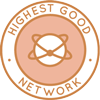 One Community is cooperatively building a world that works for everyone through open-source Highest Good Network® software which is a web-based application for collaboration, time tracking, and objective data collection. The purpose of the Highest Good Network is to provide software for internal operations and external cooperation. It is being designed for global use in support of the different countries and communities replicating the One Community sustainable village models and related components.
One Community is cooperatively building a world that works for everyone through open-source Highest Good Network® software which is a web-based application for collaboration, time tracking, and objective data collection. The purpose of the Highest Good Network is to provide software for internal operations and external cooperation. It is being designed for global use in support of the different countries and communities replicating the One Community sustainable village models and related components.
- Learn about our open-source community collaboration and management software: The Highest Good Network
This week, the core team continued their work on the Highest Good Network PRs testing, confirming the fixed PRs and resolving several issues. The confirmed fixes for several issues include adjusting formatting to reduce vertical space (#2750), implementing a MailChimp replacement (#2595), and improving load time when assigning a user to a project (#2727). Unresolved issues include the task column being too narrow, the table not stretching to the full page width on the PEOPLE REPORT PAGE UI for 375px and up (#2650), and the “Paused” and “Inactive” buttons appearing to duplicate functionality when adding a button to display paused tasks (#2817). Additionally, they reported an issue with a Core Team account not generating the correct required hours after accumulating more than five blue squares for failing to submit a Weekly Summary, and provided comments on PR#1104, questioning whether Core Team members should receive an additional required hour for their sixth blue square. We continue to focus on cooperatively building a world that works for everyone through iterative improvements and user-centric solutions. See the Highest Good Society and Highest Good Network pages for more on how this relates to cooperatively building a world that works for everyone. The collage below shows some of their work.
ALPHA SOFTWARE DEVELOPMENT TEAM
The Alpha Team’s summary, covering their work on the Highest Good Network software software was managed by Lin Khant Htel (Frontend Software Developer) and includes Carlos Gomez (Full-Stack Software Developer), Nanguan Lin (Software Developer), Rupa Rajesh Bhatia (Software Engineer), and Sheetal Mangate (Software Engineer). The Highest Good Network software is how we will manage and measure our processes for cooperatively building a world that works for everyone across our social architecture, construction, production, and maintenance processes. This week, Lin reviewed and approved PR #2880, enhancing understanding of the codebase and testing changes locally with all test cases passing. Lin also reviewed weekly summaries, photos, and videos from Alpha team members and assigned new tasks based on project priorities.
Carlos collaborated with Howard to address a time log submission issue, reconstructing frontend and backend code based on screenshots shared via Slack. Carlos also resolved an “Unknown operation GET_DATE” error in the front end by rebuilding the backend using specific npm commands. Nanguan focused on CreateNewBadgePopup.jsx, testing the implementation, and creating pull requests for solutions to identified errors. Nanguan also worked on WBS/WBSDetail/ImportTask/ImportTask.jsx, writing tests to ensure functionality. Rupa developed Pages 4, 5, and 6 for a multi-step form project, creating forms with sections for rating familiarity or interest in various design and review areas using React-controlled components. Definitely, cooperatively building a world that works for everyone requires incorporation of multiple components.
Rupa also managed state with onChange event handlers, implemented navigation with React Router, and applied custom CSS for consistent styling. She also reviewed summaries and evaluated work from Sheetal and Carlos, while gaining insights from Lin’s summary for learning purposes. Sheetal reviewed the monthlyDashboardDataReducer.js file to understand its functionality for writing test cases, including edge cases and various scenarios and monitored comments on PR #2876. See the Highest Good Society and Highest Good Network pages for more on how this relates to cooperatively building a world that works for everyone. View some of the team’s work in the collage below.
BINARY BRIGADE SOFTWARE DEVELOPMENT TEAM
The Binary Brigade Team’s summary overseeing advancements in the Highest Good Network software was managed by Vijay Anand Pandian (Full Stack Software Engineer) and includes Aaryaneil Nimbalkar (Software Developer), Anirudh Sampath Kumar (Software Developer), Ashish Nagaraju (Software Engineer), Ashmita Pandey (Software Engineer), Deepthi Kannan (Software Engineer), Huijie Liu (Software Engineer), Sandhya Adavikolanu (Software Developer), Sriram Seelamneni (Software Engineer), Xiaolu Li (Software Engineer) and Ziyu Chu (Volunteer Software Engineer). The Highest Good Network software is how we’ll be managing and objectively measuring our process for cooperatively building a world that works for everyone through our social architecture, construction, production, and maintenance processes.
This week, Aaryaneil developed unit tests for the userProjectMembersReducer, covering scenarios including returning the initial state when no action is provided, handling the GET_USER_PROJECT_MEMBERS action, and maintaining the current state for unknown actions. He also wrote tests for the wbsReducer, addressing cases such as returning the initial state for unknown actions and handling actions including FETCH_WBS_START, FETCH_WBS_ERROR, RECEIVE_WBS, ADD_NEW_WBS, ADD_NEW_WBS_ERROR, and DELETE_WBS. For the userTeamMembersReducer, he examined the initial state, the behavior of the GET_USER_TEAM_MEMBERS action, responses to unknown action types, and handling null states. Aaryaneil further validated the userProjectReducer by testing its ability to return the initial state, process the GET_USER_PROJECTS action, and preserve the current state for unknown action types. He also tested the userProfileByIdReducer.js reducer, focusing on initial state handling, actions such as GET_USER_PROFILE, EDIT_USER_PROFILE, CLEAR_USER_PROFILE, and GET_USER_TASKS, as well as verifying the functionality of the updateObject utility function and ensuring the original object remained unchanged. cooperatively building a world that works for everyone must also be validated using appropriate parameters.
Anirudh tested and verified multiple pull requests, focusing on functionality, edge cases, and bug fixes. He reviewed fixes for UI issues, such as the delete badge button on small screens (PR 2873) and user roles displayed in different modes (PR 2872). He validated unit tests for reducers like projectReportReducer (PR 2880) and timeEntriesReducer (PR 2871). Bug fixes included addressing the “Active” filter on the Projects page (PR 2865) and “Rehireable” status updates (PR 2866). He tested enhancements to the user setup process (PR 2881) and verified a status column addition (PR 2882). Anirudh also worked on a bug causing delays in reflecting account status changes on the User Management page, implementing a partial fix with ongoing work. Initiatives for cooperatively building a world that works for everyone need no delays to enhance effective implementation.
Ashish worked on Bug 1 from the Management Dashboard component, which involved adding a column header to a table. After completing the task, he submitted a pull request. He then began addressing Bug 37 in the Projects/Teams/Tasks/WBS component, which relates to an issue allowing the assignment of an end date earlier than the start date. Ashish reproduced the issue and is now in the process of analyzing and implementing the required code changes. Ashmita divided complex tasks into smaller sub-tasks, each designed to take between 40 and 60 hours to complete. She combined sections of the document to link each URL with its corresponding action items. Clear priorities were established, with a focus on urgent tasks such as building the basic framework. She identified task dependencies and sequenced work to align with the framework’s development. Uniformity is central when it comes to cooperatively building a world that works for everyone. Additionally, she reorganized the document into sub-sections to streamline task assignments and allow team members to claim tasks individually without delay.
Deepthi worked on optimizing the load performance of the earned dates feature in the featured badges section of the profile to improve functionality. She also addressed feedback on previous pull requests by implementing updates and corrections as needed. Additionally, she followed up with reviewers to facilitate re-reviews and progress toward merging the changes into the GitHub. Huijie has been mainly working on the subtask in the application page, which is the search by category function. Cooperatively building a world that works for everyone is effectively implemented in categories in order to accommodate many. She implemented the corresponding API in the backend to retrieve data and the frontend elements for the dropdown menu for users’ selection. She is now checking the redirect function for each job. Sandhya resolved a network error affecting an Axios GET request to the /volunteer stats endpoint, which retrieves data for Task Completion Analysis and Total Org Summary charts. She verified API configurations, tested with Postman, and used mock data to confirm the issue was API-related. Sandhya enhanced error handling with detailed messages and fallback mechanisms while collaborating with the backend team to address a date-parsing mismatch causing the error. After the fix, she retested the integration, ensured charts displayed real-time data, and added a loading spinner and retry logic for improved user experience.
Sriram focused on reviewing and addressing issues in an existing pull request related to sorting functionality in the Projects feature. He analyzed the previous code changes to understand the current behavior and worked on resolving bugs in the implementation. After encountering and resolving npm and Node version mismatch issues, he added the sort button to the project table, ensuring it updates as expected. Additionally, he reached out to the original author of the pull request to clarify requirements for sorting specific fields, such as “Edits,” to align the implementation with project expectations. Vijay reviewed several PRs, including adding a status column header in the Team Member Tasks tab (PR #2882), unit tests for the UserManagement.jsx file (PR #2762), and unit tests for the managingTeamsReducer file (PR #2876). He also reviewed changes that added user role display in the Tasks tab (PR #2872) and a fix for deleting badges under 1000px screen width (PR #2873). Vijay completed unit testing implementations for multiple files, including the weeklySummaryRecipientsReducer (PR #2884) and projectReportReducer (PR #2880). The shift in user role and responsiblities enahances cooperatively building a world that works for everyone.
Xiaolu completed unit tests for the ScheduleExplanationModal/ScheduleExplanationModal.jsx component. The tests validate the correct rendering of the modal title and content, ensure the proper display of the infringements list with dates and reasons, confirm the accurate rendering of time off requests, and verify that the “Close” button triggers the handleClose function. A new pull request was created for these updates. Ziyu began working on writing unit tests for a component: TimeOffRequestsTable/TimeOffRequestsTable.jsx. She created 5 test cases, providing mock data to ensure testing. These 5 tests passed on her local machine. Following this, Ziyu submitted a pull request for review. See the Highest Good Society and Highest Good Network pages for more on how this relates to cooperatively building a world that works for everyone. View some of the team’s work in the collage below.
BLUE STEEL SOFTWARE DEVELOPMENT TEAM
The Blue Steel Team’s summary, presenting their work on the Highest Good Network software was managed by Jingyi Jia (Software Engineer, Team Manager), and includes Dieu-Anh Trinh (Software Engineer), Ramakrishna Aruva (Software Engineer), and Supriya Sudini (MERN Stack Developer). The Highest Good Network software is how we’ll be managing and objectively measuring our process for cooperatively building a world that works for everyone through our social architecture, construction, production, and maintenance processes. This week, Ramakrishna resolved a bug related to data handling within a component. He delved into the data flow and manipulation logic to identify the root cause of the issue. After pinpointing the problem, he implemented a solution that effectively handles both active and inactive states, ensuring complete coverage.
Ramakrishna applied asynchronous programming techniques to enhance the efficiency and responsiveness of the application, conducting rigorous testing to confirm the reliability of the updates across all scenarios. Being responsive is an important factor in enhancing cooperatively building a world that works for everyone. Simultaneously, Jingyi resolved merge conflicts for PR #2804 and initiated a new pull request, PR #2890, to introduce a feature that prompts users for confirmation when logging intangible time, aimed at enhancing compliance with time tracking guidelines. In preparation for her impending departure, Jingyi updated all of her raised PRs with the latest development changes to avoid any potential bugs and ensure a seamless transition.
Additionally, Supriya enhanced the application’s header component by adding a conditional dropdown menu that only appears when navigating to specific project-related URLs. She implemented this feature using a React state hook to make the dropdown visible only under appropriate conditions, thereby improving the navigation’s context sensitivity and maintaining a clean interface. This dropdown provides direct access to detailed project information, improving user interaction and ensuring visual consistency across the application, including in dark mode settings. Dieu-Anh reviewed the unit test spreadsheet and found several issues, including an empty column H, missing “Route” sections, and incomplete “Has Unit Tests” entries despite task assignments. She identified inconsistent values in the “Has Unit Tests” column and recommended replacing it with a multiple-choice dropdown. See the Highest Good Society and the Highest Good Network pages to learn more on how their work contributes to cooperatively building a world that works for everyone. See below to view images of their work.
CODE CRAFTERS SOFTWARE DEVELOPMENT TEAM
The Code Crafters Team, covering their work on the Highest Good Network software, was managed by Summit Kaushal (Backend Software Developer) and includes Anoushka Gupta (Software Engineer), Ashrita Cherlapally (Software Engineer), Denish Kalariya (Software Engineer), Dhrumil Dhimantkumar Shah (Software Engineer), Humera Naaz (MERN developer), Muhideen Mustapha (Software Engineer), Muzammil Moahmmed (Software Engineer), Pavan Swaroop Lebakula (Software Engineer), Swaroop Udgaonkar (Software Engineer). The Highest Good Network software is how we’ll manage and objectively measure our process for cooperatively building a world that works for everyone through our social architecture, construction, production, and maintenance processes. This week, Swaroop updated the backend code by integrating changes from the development branch, modifying two files, writing three new functions, and adjusting three existing ones. He worked on improving screen layouts for iPads and smaller screens while researching alternative placement methods. Tasks included updating UserProfile infringements to include an array of reasons for blue square issuance and resolving placement issues for projects, people, and teams in the Reports section.
Summit debugged badge-assignment logic, focusing on streak drop-off issues, duplicate badge assignments, and cron job behaviors. He explored refactoring the code by adding conditions to verify badge eligibility and identifying edge cases requiring further testing. Anoushka tested badge functionalities, reviewed a bug document, and started developing a job search feature, implementing APIs to filter jobs by title, sort by recency, and retrieve summaries based on user interactions. Dhrumil resolved inaccuracies in the “Projects With Completed Hours” report and provided updates on pull requests during a team call. Cooperatively building a world that works for everyone is only achievable by maintaining accurate data and consistency in reporting. Humera reviewed the logic of the checkMostHrsWeek function to ensure proper badge count increments and new badge additions to MongoDB. She investigated a database error related to the myTeam schema, consulting teammates for insights. Muhideen tested multiple badge components using debugging tools and reviewed pull requests to verify bug fixes and implementations, covering various badge functionalities.
Denish addressed issues in the Volunteer Activities tab by refining the backend code to improve the retrieval and presentation of total volunteer hours, testing API calls, and debugging discrepancies in reported metrics. Pavan worked on the User Management page, adding a “Title” column and adjusting the “Role” column width, implementing changes across frontend and backend systems. Ashrita reviewed badge-related code changes to ensure proper functionality and debugged issues with the “Most Hours Worked” badge. She also began developing a badge management component to display user badge assignments, including features to view user details by hovering over badges. See the Highest Good Society and Highest Good Network pages for more on how this relates to cooperatively building a world that works for everyone. View some of the team’s work in the collage below.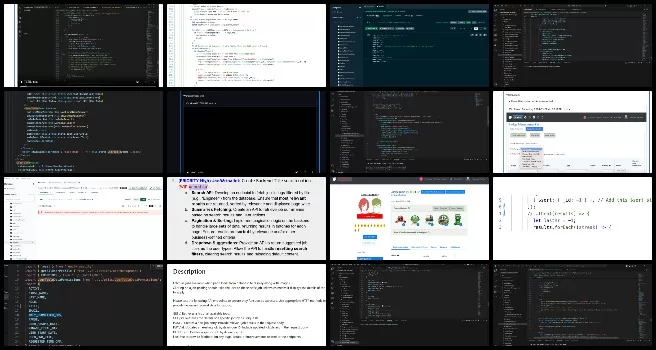
DEV DYNASTY SOFTWARE DEVELOPMENT TEAM
The Dev Dynasty Team’s summary, covering their work on the Highest Good Network software, was managed by Jatin Agrawal (Software Engineer) and includes Fangle Xi (Software Engineer), Nikita Kolla (Full Stack Developer), Nishita Gudiniye (Software Engineer), Sailavanya Narthu (Software Engineer), Shreya Vithala (Software Engineer) and Varun Elangovan (Software Engineer). The Highest Good Network software is how we’ll manage and objectively measure our process for cooperatively building a world that works for everyone through our social architecture, construction, production, and maintenance processes. This week, Fangle began researching the new API and discovered it may require support for company accounts and icons. The task is proving to be more complex than initially anticipated, especially since the API update cannot be directly used with account passwords for login. She has also been assisting a coworker with a code review. Jatin worked on implementing functionality to create various application question sets, developing both the frontend and backend components for the task. He created a customizable form to accommodate multiple job applications and prepared corresponding database models. Additionally, he wrote tests to ensure the models’ reliability and defined the necessary routes and controllers to support the feature.
Nishita worked on the “Team Stats – Comparison Needed” component in the total organization summary section, adding metrics to track and compare the number of users in teams versus those not in teams over time. She applied percentage changes, ensured data validation standards were met, refined data processing methods to improve the representation of team dynamics, and created a pull request for these changes. Nikita resolved issues with previously raised pull requests, addressing merge conflicts related to the React input components task and queries for the badge assignment task. She began work on a social media scheduler for Tumblr by researching the Tumblr API and developing an initial prototype for the component. Timed regular updates on the social media channel is a success factor in cooperatively building a world that works for everyone. Sailavanya addressed issues related to a blank page in the application caused by API token handling during CI builds, identifying the root cause by analyzing build logs and debugging the authentication flow. She updated token management logic to ensure proper handling in the CI pipeline, conducted testing to validate the fix, and documented additional failures in other components discovered during testing, providing recommendations for further analysis.
Shreya completed the User Management task by implementing sorting functionality to ensure newly added users appear at the top of the list upon refreshing, started a new Figma task as part of phase 3 documentation to work on prototyping designs, and verified the work of three team members in her role as a manager-in-training, reporting her assessments to Jatin. Varun verified the Anniversary Celebrated feature, which enables emails to be sent to individuals celebrating anniversaries, as well as the Global Volunteer Network Map feature, which displays a scalable map showing the locations of volunteers. He also updated all his findings in the Total Org Summary Google Sheets. See the Highest Good Society and Highest Good Network pages for more on how this relates to cooperatively building a world that works for everyone. View some of the team’s work in the collage below.
EXPRESSERS SOFTWARE DEVELOPMENT TEAM
The Expressers Team’s summary, covering their work on the Highest Good Network software, was managed by Christy Guo (Software Engineer) and includes Aishwarya Ramesh (Software Engineer), Faye Lyu (Software Engineer), Haoqing Zhu (Software Engineer), Howie Miao (Software Engineer), Rahul Trivedi (Software Developer), Reina Takahara (Software Developer), Shreya Laheri (Software Developer), and Strallia Chao (Software Engineer). The Highest Good Network software is how we’ll manage and objectively measure our process for cooperatively building a world that works for everyone through our social architecture, construction, production, and maintenance processes. This week, Aishwarya completed the showtrophyicon anniversaries functionality by implementing and integrating both frontend and backend logic. Christy worked on enhancing the ProjectTaskChart component in React, integrating features such as sorting tasks by date or hours and filtering tasks by completion status.
Faye addressed a BSON type bug, refactored code for improved efficiency, and validated pipeline updates using MongoDB and Postman. Haoqing focused on resolving formatting issues on the People Report page, specifically fixing bugs related to top alignment of components. Howie resolved a system date issue and implemented a hotfix to address actions in the development branch. Rahul advanced the HGN Form by finalizing Page 2 with various input types and started development on Page 3. Reina implemented tag management functionality and integrated Axios for handling HTTP requests. Shreya finalized phase 3 documentation by incorporating team feedback and organizing deliverables into actionable tasks. Strallia concentrated on backend tasks related to the Total Org Summary page. See the Highest Good Society and Highest Good Network pages for more on how this relates to cooperatively building a world that works for everyone. See the collage below to view the team’s work this week.
LUCKY STAR SOFTWARE DEVELOPMENT TEAM
The Lucky Star Team’s summary, covering their work on the Highest Good Network software, was managed by Anne Zhang (Software Engineer) and includes contributions from Chetan Sunku (Software Engineer), Koushica Bosadi Ulaganathan (Software Engineer), Nikhitha Kalinga (Software Engineer), T R Samarth Urs (Data Analyst), Vaibhavi Madhav Deshpande (Software Engineer), Yashwanth Pokala (Software Engineer) and Ziyan Wang (Software Engineer). This week, Chetan continued working on the issue related to time updates not automatically reflecting on the dashboard without a page reload, after completing a previous hotfix. He investigated the problem and sought assistance in the coding channel but did not receive any responses. Koushica worked on enhancing the functionality of the Dashboard’s Tasks tab by integrating Google Docs and Manager icons. She improved user interaction by adding distinct role colors, clickable profile links, and hover displays. She also reviewed and approved PR #2801, addressing issues with the Add Time Entry button and incorrect user profile data. Cooperatively building a world that works for everyone is automation-dependent for effective updates and dissemination.
Nikhitha resolved display issues in the Team Member Tasks section on smaller screens, fixing bugs where team member names were hidden and the section froze or shook during scrolling. She tested the changes under different user roles and across light and dark modes before submitting a pull request. Samarth managed a PR review team, evaluating their work, reviewing uploaded images, and providing feedback. He summarized the team’s work in a blog post, which included a collage of their images. Vaibhavi worked on action items for the HGN Phase III document, collaborating with teammates to define sub-deliverables and providing feedback to the UI team on integrating a poll tracking system in Figma. System tracking especially of tasks is important in enhancing cooperatively building a world that works for everyone.
Yashwanth focused on resolving bugs, fixing an issue with duplicate entries in the permission log table, and implementing design changes to improve its structure. He also addressed the “Missing Asterisk” bug and reviewed the overall implementation of the permission log feature. Ziyan identified and resolved an alignment issue with the Teams button and input field, traced the problem to a specific PR and code change, and updated the corresponding tasks in the documentation and the Phase 2 WBS Excel sheet. This week, Anne worked on fixing the member column filter bug in the Projects table, addressing an issue where the table could not be sorted by the number of active members. She encountered an error when clicking the sort button (ERR_INSUFFICIENT_RESOURCES) and attempted to resolve it using caching, but the issue persists. Anne also managed tasks within her team, Lucky Star, reviewed team photos and videos and submitted weekly summaries. Learn more about how the Highest Good Society and Highest Good Network measures and assists in cooperatively building a world that works for everyone in the Highest Good Network open source hub. The collage below shows a compilation of the work from this team.
MOONFALL SOFTWARE DEVELOPMENT TEAM
The Moonfall Team’s summary, covering their work on the Highest Good Network software was managed by Satya Shanthi Tadiparthi (Team Manager), and includes Bhavya Prakash (Software Engineer), Calvin Liu (PR Team), Navya Sri Ankireddy (PR Team), Newell Newell (PR Team I-N), Nikhil Giri (Software Engineer), Rachana Zha (Software Engineer), Rashmitha Yadav (Software Engineer), Shashank Kumar (Software Engineer), Swathi Dharma Sankaran (Software Engineer), Vedant Gandhi (Software Engineer), and Yili Sun (Software Engineer). This week, Bhavya reviewed documentation to identify potential tasks and explored different schemas. She engaged the community forum to address a lead badge bug, while examining the GitHub repository for insights and testing solutions. Calvin submitted materials for One Community Global recognition and worked on optimizing system performance. He addressed Bug 21, involving the “Add Intangible Time Entry” feature. Navya implemented a new “Tracking Button” permission for advanced management and positioned it under “User Management” to enhance access control and streamline updates. Newell updated PHP from 8.2 to 8.3 and resolved WordPress plugin issues. He completed backend development for a leaderboard system and achieved a website benchmark score of 100.
Nikhil addressed frontend and backend issues related to the “Add New User” popup by implementing toast notifications and asynchronous email operations, while analyzing PR conflicts and resolving layout issues on the Project Report Page. Rachana worked on implementing gzip compression in an Express.js application and created a GitHub branch for the enhancement. She assisted with workspace setup issues. Rashmitha reviewed multiple PRs and tested implemented features. She uploaded related screenshots. Satya reviewed and tested PRs for functionalities like TimeOffRequestsTable and User Management, managed team summaries, and reported on weekly progress. Shashank resolved a button alignment issue and tested the “Final Day” button but delayed the PR due to pending clarifications. Swathi addressed a UI jump issue in the tasks module by updating JavaScript and CSS and ensured resource alignment. She updated headers to display project names dynamically. Vedant fixed a dark mode issue in the project delete modal and raised a related pull request. He addressed test failures. Yili resolved issues affecting non-Owner/Admin accounts with edit permissions, fixed related unit tests, resolved merge conflicts, and addressed freezing issues caused by active buttons. See the Highest Good Society and Highest Good Network pages for more on how this relates to cooperatively building a world that works for everyone. Below is a collage for the team’s work.
REACTONAUTS SOFTWARE DEVELOPMENT TEAM
Reactonauts’ Team’s summary, covering their work on the Highest Good Network software, was managed by Vijeth Venkatesha (Software Engineer) and includes Dhairya Mehta (Software Engineer), Gmon Kuzhiyanikkal (Software Engineer), Haoyue Wen (Software Engineer), Khushi Jain (PR Team I-N), Mohan Gadde (Software Engineer), Nikhil Pittala (Software Engineer), Pallavi Thorat (PR Team O-Sh), Peterson Rodrigues (Full-Stack MERN Stack Developer), Rishitha Mamidala (Software Engineer), Saniya Farheen (Software Engineer), Sharadha Shivakumar (Software Engineer), and Vikram Badhan (Software Engineer). This week, Dhairya worked on the “Fix Projects find user function” task and identified the root cause of an issue affecting user discovery in the projects section. She developed a sort and search function to optimize user assignment processes. Gmon addressed the addition of bell notifications for task deadlines and resolved 404 errors. He completed work on adding active/inactive team numbers in the team page and created a new pull request (PR 2850) while awaiting final approval for PR 2609. Haoyue enhanced the FAQ tool by improving user search functionality and created a structured database for FAQs. She implemented features to log unanswered questions, send email notifications, and configure permissions. Khushi reviewed and updated the Phase 3 document by resolving comments, integrating feedback, and collaborating with team members to ensure accuracy and clarity in both content and visuals.
Mohan optimized the project list’s organization and resolved visibility toggle issues in user profiles. He addressed merge conflicts related to the team auto-save feature. Nikhil reviewed 12 pull requests involving frontend, backend, and unit testing tasks to ensure code quality and functionality. He made updates to the removeTaskFromUser function, focusing on simplifying logic, refining mapping, and improving integration between frontend and backend systems. Peterson improved the “My Team” filter in the “Leaderboard” table by enhancing the dropdown menu’s appearance, scroll functionality, and team member display. Rishitha implemented a percentage toggle feature for the People Report and added tooltips. She enhanced the display of percentage labels in charts. Saniya resolved a bug and submitted relevant screenshots and recordings. She requested Git access to create a pull request. Sharadha addressed a screen-shaking issue in the team member task section for smaller screens and verified functionality across user roles and devices. She created PR 2888. Vijeth identified load delay issues and data retention problems when switching dashboards. He conducted meetings, gathered updates, and managed team operations. See the Highest Good Society and Highest Good Network pages for more on how this relates to cooperatively building a world that works for everyone. Below is a collage for the team’s work:
SKYE SOFTWARE DEVELOPMENT TEAM
Skye Team’s summary covering their work on the Highest Good Network was managed by Rishabh Rao (Administrator) and Luis Arevalo (Software Engineer) and the team includes Abi Liu (Software Developer), Laura Cohen (Software Engineer), Sai Preetham (Full Stack Developer), Snehal Dilip Patare (Software Engineer), Yao Wang (Software Engineer) and Zhimin Liang (Full Stack Developer). The Highest Good Network software is how we’ll manage and objectively measure our process for cooperatively building a world that works for everyone through our social architecture, construction, production, and maintenance processes.
This week, Abi worked on debugging a query that, while no longer throwing errors, was still not returning correct results. He focused on researching, analyzing the problem, and consulting documentation to achieve a non-error response and identify potential solutions. Additionally, he reviewed and merged pull requests submitted by teammates to ensure smooth integration of their changes into the project. Laura finalized hard-coding the permission presets file to address back-end authorization issues and integrated it into the permission change modal by updating useEffects and related functions. She met with her manager to troubleshoot back-end issues and decided to update the back-end herself to resolve problems affecting the front end. Laura also fixed minor modal bugs to improve user-friendliness, reached her 80-hour milestone to qualify as an official team member, and completed her bio for the website by cooperatively building a world that works for everyone.
Yao worked on addressing a 401 error code associated with a LinkedIn post feature by analyzing router and controller implementations with input from the team lead, although the issue remained unresolved. Yao also started testing environment variables and implementing schedule posts and posts with media functionalities. Snehal resolved a merge conflict for PR2801, which was delayed by site performance issues and is now awaiting approval, addressed a failing test case in member.test.jsx for PR2862 with all test cases now passing and pending approval, and began developing a new feature to generate an auto-poster for Facebook and Facebook groups for cooperatively building a world that works for everyone.
Zhimin focused on front-end development for the YouTube auto-poster project, implementing components to interact with the backend. While working on the front end. Zhimin identified logic errors in the backend and plans to address these issues while connecting the front end and back end to ensure functionality. Sai Preetham worked on pull requests #2816 and #2864, resolving merge conflicts and fixing issues with the search functionality per project requirements, verifying that updates worked as intended. Sai also prepared the weekly summary and organized Dropbox images for the project cooperatively building a world that works for everyone’s documentation.
Luis worked on creating new warnings and making adjustments to the “get special warnings” route to ensure compatibility with updated data. He implemented functionality that allows users to assign warnings based on the button clicked, accounted for the current user’s warnings, and made adjustments for issuing a blue square and a warning. Additionally, he began working on functionality for a button that issues warnings for both “no summary” and “not enough hours.” See the Highest Good Society and the Highest Good Network pages to learn more about how their work contributes to cooperatively building a world that works for everyone. See below for the work done by the group.
SOFTWARE PR REVIEW TEAM A-K
The PR Review Team’s summaries for team members’ names starting with A-K and covering their work on the Highest Good Network software was managed by Anoushka Hazari (Data Analyst). The Highest Good Network software is a foundation of what we’ll be using to measure our results for cooperatively building a world that works for everyone. This week’s active members of this team were: Abdelmounaim Lallouache (Software Developer), Carl Bebli (Software Engineer) and Kurtis Ivey (Full Stack Developer). They reviewed all the Highest Good Network PRs (Pull Requests) shared in this week’s update. Learn more about how the Highest Good Network will measure and assist in cooperatively building a world that works for everyone in the Highest Good Network open source hub. The collage below shows a compilation of the work from this team.
SOFTWARE PR REVIEW TEAM L-Sg
The PR Review Team’s summary for team members’ names starting with L-Sg and covering their work on the Highest Good Network software was managed by Saumit Chinchkhandi (Administrative Assistant and Software Engineer). The Highest Good Network software is a foundation of what we’ll be using to measure our results of cooperatively building a world that works for everyone. This week’s active members of this team were: Nahiyan Ahmed (Full Stack Software Developer), Nathan Hoffman (Software Engineer), and Pratyush Prasanna Sahu (Software Engineer). They reviewed all the Highest Good Network PRs (Pull Requests) shared in this week’s update. Learn more about how the Highest Good Network measures and assists in cooperatively building a world that works for everyone in the Highest Good Network open source hub. The collage below shows a compilation of the work from this team.
SOFTWARE PR REVIEW TEAM Sh-Z
The PR Review Team’s summary for team members’ names starting with Sh-Z and covering their work on the Highest Good Network software was managed by Olawunmi “Ola” Ijisesan (Administrative and Management Support) and Samarth Urs (Administrative Assistant and Data Analyst). The Highest Good Network software forms the foundation for measuring our results in cooperatively building a world that works for everyone. This week’s active members of this team were: Sujith Reddy Sudini (Mern Stack Developer, Full Stack Developer, Software Developer) and Neeharika Koniki (Software Engineer, Developer). They reviewed all the Highest Good Network PRs (Pull Requests) shared in this week’s update. Learn more about how the Highest Good Network will measure and assist in cooperatively building a world that works for everyone through the Highest Good Network open-source hub. The collage below shows a compilation of the work from this team.
AND WE PRODUCED THIS WEEKLY UPDATES BLOG – CLICK HERE TO SUBSCRIBE
FOLLOW ONE COMMUNITY’S PROGRESS (click icons for our pages)
INVESTOR PAGES
GET INVOLVED
DONATE | WAYS ANYONE CAN HELP | MEMBERSHIP
CLICK HERE FOR ALL PAST UPDATES
 One Community
One Community

